Recent Advances in the Synthesis of Pyrazole Derivatives: A Review
Abstract
:1. Introduction
2. The Primary Approaches for Obtaining the Pyrazole Nucleus
- ▪ Cyclocondensation of hydrazine’s and similar nuclei with carbonyl systems;
- ▪ Multicomponent reactions;
- ▪ Dipolar cycloadditions.
2.1. Cyclocondensation of Hydrazine and Its Derivatives on 1,3-Difunctional Systems
2.1.1. Pyrazoles from 1,3-Diketones
2.1.2. Pyrazoles from Vinyl Ketones and Vinyl Ketones Having a Leaving Group
2.1.3. Pyrazoles from Acetylenic Ketones
2.2. Dipolar Cycloadditions
2.2.1. Pyrazoles from Diazo Compounds
2.2.2. Pyrazoles from Nitrilimines
2.2.3. Pyrazoles from Sydnones
2.3. Multicomponent Synthesis
3. Conclusions
Author Contributions
Funding
Acknowledgments
Conflicts of Interest
References
- Knorr, L. Einwirkung von Acetessigester auf Phenylhydrazin. Berichte Dtsch. Chem. Ges. 1883, 16, 2597–2599. [Google Scholar] [CrossRef]
- Buchner, E. Ein Isomeres des Glyxalins. Berichte Dtsch. Chem. Ges. 1889, 22, 2165–2167. [Google Scholar] [CrossRef]
- Karrouchi, K.; Radi, S.; Ramli, Y.; Taoufik, J.; Mabkhot, Y.; Al-aizari, F.; Ansar, M. Synthesis and Pharmacological Activities of Pyrazole Derivatives: A Review. Molecules 2018, 23, 134. [Google Scholar] [CrossRef]
- Karrouchi, K.; Mortada, S.; Issaoui, N.; El-guourrami, O.; Arshad, S.; Bouatia, M.; Sagaama, A.; Benzeid, H.; Karbane, M.E.; Faouzi, M.E.A.; et al. Synthesis, crystal structure, spectroscopic, antidiabetic, antioxidant and computational investigations of Ethyl 5-hydroxy-1-isonicotinoyl-3-methyl-4,5-dihydro-1H-pyrazole-5-carboxylate. J. Mol. Struct. 2022, 1251, 131977. [Google Scholar] [CrossRef]
- Meng, Y.; Zhang, T.; Gong, X.; Zhang, M.; Zhu, C. Visible-light promoted one-pot synthesis of pyrazoles from alkynes and hydrazines. Tetrahedron Lett. 2019, 60, 171–174. [Google Scholar] [CrossRef]
- Bennani, F.E.; Doudach, L.; Cherrah, Y.; Ramli, Y.; Karrouchi, K.; Ansar, M.; Faouzi, M.E.A. Overview of recent developments of pyrazole derivatives as an anticancer agent in different cell line. Bioorganic Chem. 2020, 97, 103470. [Google Scholar] [CrossRef]
- Ansari, A.; Ali, A.; Asif, M.; Shamsuzzaman, S. Review: Biologically active pyrazole derivatives. New J. Chem. 2017, 41, 16–41. [Google Scholar] [CrossRef]
- Fustero, S.; Sánchez-Roselló, M.; Barrio, P.; Simón-Fuentes, A. From 2000 to Mid-2010: A Fruitful Decade for the Synthesis of Pyrazoles. Chem. Rev. 2011, 111, 6984–7034. [Google Scholar] [CrossRef]
- Nitulescu, G.M.; Stancov, G.; Seremet, O.C.; Nitulescu, G.; Mihai, D.P.; Duta-Bratu, C.G.; Barbuceanu, S.F.; Olaru, O.T. The Importance of the Pyrazole Scaffold in the Design of Protein Kinases Inhibitors as Targeted Anticancer Therapies. Molecules 2023, 28, 5359. [Google Scholar] [CrossRef]
- Rue, K.L.; Herrera, S.; Chakraborty, I.; Mebel, A.M.; Raptis, R.G. Completion of Crystallographic Data for the Series of 4-Halogenated-1H-pyrazoles: Crystal Structure Determination of 4-Iodo-1H-pyrazole and Spectroscopic Comparison. Crystals 2023, 13, 1101. [Google Scholar] [CrossRef]
- Konwar, M.; Phukan, P.; Chaliha, A.K.; Buragohain, A.K.; Damarla, K.; Gogoi, D.; Kumar, A.; Sarma, D. An Unexplored Lewis Acidic Catalytic System for Synthesis of Pyrazole and its Biaryls Derivatives with Antimicrobial Activities through Cycloaddition-Iodination-Suzuki Reaction. ChemistrySelect 2019, 4, 10236–10245. [Google Scholar] [CrossRef]
- Xu, Y.; Chen, Q.; Tian, Y.; Wu, W.; You, Y.; Weng, Z. Silver-catalyzed synthesis of 5-aryl-3-trifluoromethyl pyrazoles. Tetrahedron Lett. 2020, 61, 151455. [Google Scholar] [CrossRef]
- Poletto, J.; Ribeiro, G.M.; Da Silva, M.J.V.; Jacomini, A.P.; Basso, E.A.; Back, D.F.; Moura, S.; Rosa, F.A. One-Pot Highly Regioselective Synthesis of α-Ketoamide N-Arylpyrazoles from Secondary β-Enamino Diketones. Org. Lett. 2019, 21, 6325–6328. [Google Scholar] [CrossRef] [PubMed]
- Kim, J.K.; Gong, M.; Shokova, E.A.; Tafeenko, V.A.; Kovaleva, O.V.; Wu, Y.; Kovalev, V.V. Pyrazoles: ‘one-pot’ synthesis from arenes and carboxylic acids. Org. Biomol. Chem. 2020, 18, 5625–5638. [Google Scholar] [CrossRef]
- Girish, Y.R.; Kumar, K.S.S.; Manasa, H.S.; Shashikanth, S. ZnO: An Ecofriendly, Green Nano-catalyst for the Synthesis of Pyrazole Derivatives under Aqueous Media. J. Chin. Chem. Soc. 2014, 61, 1175–1179. [Google Scholar] [CrossRef]
- Gosselin, F.; O’Shea, P.; Webster, R.; Reamer, R.; Tillyer, R.; Grabowski, E. Highly Regioselective Synthesis of 1-Aryl-3,4,5-Substituted Pyrazoles. Synlett 2006, 2006, 3267–3270. [Google Scholar] [CrossRef]
- Heller, S.T.; Natarajan, S.R. 1,3-Diketones from Acid Chlorides and Ketones: A Rapid and General One-Pot Synthesis of Pyrazoles. Org. Lett. 2006, 8, 2675–2678. [Google Scholar] [CrossRef]
- Komendantova, A.S.; Lyssenko, K.A.; Zavarzin, I.V.; Volkova, Y.A. Iodine-promoted synthesis of pyrazoles from 1,3-dicarbonyl compounds and oxamic acid thiohydrazides. Org. Chem. Front. 2020, 7, 1640–1646. [Google Scholar] [CrossRef]
- Yang, G.; Liu, Y.; Lin, X.; Ming, B.; Li, K.; Hu, C. Self-assembly of a new 3D platelike ternary-oxo-cluster: An efficient catalyst for the synthesis of pyrazoles. Chin. Chem. Lett. 2022, 33, 354–357. [Google Scholar] [CrossRef]
- Chandak, H.S.; Lad, N.P.; Dange, D.S. Greener and facile aqueous synthesis of pyrazoles using Amberlyst-70 as a recyclable catalyst. Green Chem. Lett. Rev. 2012, 5, 135–138. [Google Scholar] [CrossRef]
- Liu, Y.-F.; Li, K.; Lian, H.-Y.; Chen, X.-J.; Zhang, X.-L.; Yang, G.-P. Self-Assembly of a U(VI)-Containing Polytungstate Tetramer with Lewis Acid-Base Catalytic Activity for a Dehydration Condensation Reaction. Inorg. Chem. 2022, 61, 20358–20364. [Google Scholar] [CrossRef] [PubMed]
- Corradi, A.; Leonelli, C.; Rizzuti, A.; Rosa, R.; Veronesi, P.; Grandi, R.; Baldassari, S.; Villa, C. New “Green” Approaches to the Synthesis of Pyrazole Derivatives. Molecules 2007, 12, 1482–1495. [Google Scholar] [CrossRef] [PubMed]
- Huang, Y.R.; Katzenellenbogen, J.A. Regioselective Synthesis of 1,3,5-Triaryl-4-alkylpyrazoles: Novel Ligands for the Estrogen Receptor. Org. Lett. 2000, 2, 2833–2836. [Google Scholar] [CrossRef] [PubMed]
- Rao, V.K.; Tiwari, R.; Chhikara, B.S.; Shirazi, A.N.; Parang, K.; Kumar, A. Copper triflate-mediated synthesis of 1,3,5-triarylpyrazoles in [bmim][PF6] ionic liquid and evaluation of their anticancer activities. RSC Adv. 2013, 3, 15396. [Google Scholar] [CrossRef]
- Bhat, B.A.; Puri, S.C.; Qurishi, M.A.; Dhar, K.L.; Qazi, G.N. Synthesis of 3,5-Diphenyl-1H-Pyrazoles. Synth. Commun. 2005, 35, 1135–1142. [Google Scholar] [CrossRef]
- Gerus, I.I.; Zhuk, Y.I.; Kacharova, L.M.; Röschenthaler, G.-V.; Shaitanova, E.N.; Sorochinskii, A.E.; Vdovenko, S.I.; Wojcik, J. Uncommon fluorination of enones with xenon difluoride. J. Fluor. Chem. 2020, 229, 109413. [Google Scholar] [CrossRef]
- Stephan, M.; Panther, J.; Wilbert, F.; Ozog, P.; Müller, T.J.J. Heck Reactions of Acrolein or Enones and Aryl Bromides—Synthesis of 3-Aryl Propenals or Propenones and Consecutive Application in Multicomponent Pyrazole Syntheses. Eur. J. Org. Chem. 2020, 2020, 2086–2092. [Google Scholar] [CrossRef]
- Paul Raj, J.; Gangaprasad, D.; Karthikeyan, K.; Rengasamy, R.; Kesavan, M.; Venkateswarulu, M.; Vajjiravel, M.; Elangovan, J. A new route to synthesis of substituted pyrazoles through oxidative [3+2] cycloaddition of electron deficient alkenes and diazocarbonyl compounds. Tetrahedron Lett. 2018, 59, 4462–4465. [Google Scholar] [CrossRef]
- Pizzuti, L.; Martins, P.L.G.; Ribeiro, B.A.; Quina, F.H.; Pinto, E.; Flores, A.F.C.; Venzke, D.; Pereira, C.M.P. Efficient sonochemical synthesis of novel 3,5-diaryl-4,5-dihydro-1H-pyrazole-1-carboximidamides. Ultrason. Sonochem. 2010, 17, 34–37. [Google Scholar] [CrossRef]
- Iminov, R.T.; Mashkov, A.V.; Vyzir, I.I.; Chalyk, B.A.; Tverdokhlebov, A.V.; Mykhailiuk, P.K.; Babichenko, L.N.; Tolmachev, A.A.; Volovenko, Y.M.; Biitseva, A.; et al. Multigram Synthesis of Fluoroalkyl-Substituted Pyrazole-4-carboxylic Acids: Fluoroalkyl-Substituted Pyrazole-4-carboxylic Acids. Eur. J. Org. Chem. 2015, 2015, 886–891. [Google Scholar] [CrossRef]
- Tian, L.; Wan, J.; Sheng, S. Transition Metal-free C−H Sulfonylation and Pyrazole Annulation Cascade for the Synthesis of 4-Sulfonyl Pyrazoles. ChemCatChem 2020, 12, 2533–2537. [Google Scholar] [CrossRef]
- Moureu, C.; Delange, R. Over some Acetylenketone and over a new method to the synthesis of β-Diketones. Bull. Soc. Chim. 1901, 25, 302–313. [Google Scholar]
- Zora, M.; Demirci, D.; Kivrak, A.; Kelgokmen, Y. One-pot synthesis of 4-(phenylselanyl)-substituted pyrazoles. Tetrahedron Lett. 2016, 57, 993–997. [Google Scholar] [CrossRef]
- Bhaskaran, R.P.; Janardhanan, J.C.; Babu, B.P. Metal-Free Synthesis of Pyrazoles and Chromenopyrazoles from Hydrazones and Acetylenic Esters. ChemistrySelect 2020, 5, 4822–4825. [Google Scholar] [CrossRef]
- Savel’ev, V.A.; Kotova, A.A.; Rybalova, T.V.; Shults, E.E. Regioselective Synthesis of 1,3,5-Trisubstituted Pyrazoles Containing an Anthranilic Acid Motif. Chem. Heterocycl. Compd. 2019, 55, 943–955. [Google Scholar] [CrossRef]
- Thirukovela, N.S.; Balaboina, R.; Botla, V.; Vadde, R.; Jonnalagadda, S.B.; Vasam, C.S. One-pot regioselective synthesis of substituted pyrazoles and isoxazoles in PEG-400/water medium by Cu-free nano-Pd catalyzed sequential acyl Sonogashira coupling-intramolecular cyclization. Catal. Sci. Technol. 2019, 9, 6471–6481. [Google Scholar] [CrossRef]
- Topchiy, M.A.; Zharkova, D.A.; Asachenko, A.F.; Muzalevskiy, V.M.; Chertkov, V.A.; Nenajdenko, V.G.; Nechaev, M.S. Mild and Regioselective Synthesis of 3-CF3-Pyrazoles by the AgOTf-Catalysed Reaction of CF3-Ynones with Hydrazines. Eur. J. Org. Chem. 2018, 2018, 3750–3755. [Google Scholar] [CrossRef]
- Yu, X.; Shang, Y.-Z.; Cheng, Y.-F.; Tian, J.; Niu, Y.; Gao, W.-C. Synthesis of 4-chalcogenyl pyrazoles via electrophilic chalcogenation/cyclization of α,β-alkynic hydrazones. Org. Biomol. Chem. 2020, 18, 1806–1811. [Google Scholar] [CrossRef]
- Li, D.; Qiu, S.; Chen, Y.; Wu, L. K2CO3-Promoted Pyrazoles Synthesis from 1,3-Dipolar Cycloaddition of N-Tosylhydrazones with Acetylene Gas. ChemistrySelect 2020, 5, 12034–12037. [Google Scholar] [CrossRef]
- Devi, L.; Sharma, G.; Kant, R.; Shukla, S.K.; Rastogi, N. Regioselective synthesis of functionalized pyrazole-chalcones via a base mediated reaction of diazo compounds with pyrylium salts. Org. Biomol. Chem. 2021, 19, 4132–4136. [Google Scholar] [CrossRef]
- Zhao, P.; Zeng, Z.; Feng, X.; Liu, X. Multisubstituted pyrazole synthesis via [3 + 2] cycloaddition/rearrangement/N H insertion cascade reaction of α-diazoesters and ynones. Chin. Chem. Lett. 2021, 32, 132–135. [Google Scholar] [CrossRef]
- Kula, K.; Kącka-Zych, A.; Łapczuk-Krygier, A.; Wzorek, Z.; Nowak, A.K.; Jasiński, R. Experimental and Theoretical Mechanistic Study on the Thermal Decomposition of 3,3-diphenyl-4-(trichloromethyl)-5-nitropyrazoline. Molecules 2021, 26, 1364. [Google Scholar] [CrossRef] [PubMed]
- Ledovskaya, M.S.; Voronin, V.V.; Polynski, M.V.; Lebedev, A.N.; Ananikov, V.P. Primary Vinyl Ethers as Acetylene Surrogate: A Flexible Tool for Deuterium-Labeled Pyrazole Synthesis. Eur. J. Org. Chem. 2020, 2020, 4571–4580. [Google Scholar] [CrossRef]
- Zhu, J.-N.; Wang, W.-K.; Jin, Z.-H.; Wang, Q.-K.; Zhao, S.-Y. Pyrrolo[3,4-c]pyrazole Synthesis via Copper(Ι) Chloride-Catalyzed Oxidative Coupling of Hydrazones to Maleimides. Org. Lett. 2019, 21, 5046–5050. [Google Scholar] [CrossRef]
- Yi, F.; Zhao, W.; Wang, Z.; Bi, X. Silver-Mediated [3 + 2] Cycloaddition of Alkynes and N -Isocyanoiminotriphenylphosphorane: Access to Monosubstituted Pyrazoles. Org. Lett. 2019, 21, 3158–3161. [Google Scholar] [CrossRef] [PubMed]
- Han, T.; Wang, K.-H.; Yang, M.; Zhao, P.; Wang, F.; Wang, J.; Huang, D.; Hu, Y. Synthesis of Difluoromethylated Pyrazoles by the [3 + 2] Cycloaddition Reaction of Difluoroacetohydrazonoyl Bromides. J. Org. Chem. 2022, 87, 498–511. [Google Scholar] [CrossRef] [PubMed]
- Kula, K.; Łapczuk, A.; Sadowski, M.; Kras, J.; Zawadzińska, K.; Demchuk, O.M.; Gaurav, G.K.; Wróblewska, A.; Jasiński, R. On the Question of the Formation of Nitro-Functionalized 2,4-Pyrazole Analogs on the Basis of Nitrylimine Molecular Systems and 3,3,3-Trichloro-1-Nitroprop-1-Ene. Molecules 2022, 27, 8409. [Google Scholar] [CrossRef]
- Bouton, J.; Van Calenbergh, S.; Hullaert, J. Sydnone Ribosides as a Platform for the Synthesis of Pyrazole C-Nucleosides: A Unified Synthesis of Formycin B and Pyrazofurin. Org. Lett. 2020, 22, 9287–9291. [Google Scholar] [CrossRef]
- Lakeland, C.P.; Watson, D.W.; Harrity, J.P.A. Exploiting Synergistic Catalysis for an Ambient Temperature Photocycloaddition to Pyrazoles. Chem. Eur. J. 2020, 26, 155–159. [Google Scholar] [CrossRef]
- Delaunay, T.; Genix, P.; Es-Sayed, M.; Vors, J.-P.; Monteiro, N.; Balme, G. A Modular Sydnone Cycloaddition/Suzuki−Miyaura Cross-Coupling Strategy to Unsymmetrical 3,5-Bis(hetero)aromatic Pyrazoles. Org. Lett. 2010, 12, 3328–3331. [Google Scholar] [CrossRef]
- Chen, J.; Chen, D.; Kuang, J.; Ma, Y. Transition Metal-Free De Novo Synthesis of Sulfonated Pyrazoles from Sulfonyl Hydrazides, 1,3-Diketones, and Sodium Sulfinates at Room Temperature. J. Org. Chem. 2021, 86, 9289–9298. [Google Scholar] [CrossRef] [PubMed]
- Jacob, R.; De Oliveira, D.; Peglow, T.; Nascimento, J.; Bartz, R. Oxone®-Promoted One-Pot Synthesis of 1-Aryl-4-(organylselanyl)-1H-pyrazoles. J. Braz. Chem. Soc. 2019, 30, 2144–2152. [Google Scholar] [CrossRef]
- Pearce, A.J.; Harkins, R.P.; Reiner, B.R.; Wotal, A.C.; Dunscomb, R.J.; Tonks, I.A. Multicomponent Pyrazole Synthesis from Alkynes, Nitriles, and Titanium Imido Complexes via Oxidatively Induced N-N Bond Coupling. J. Am. Chem. Soc. 2020, 142, 4390–4399. [Google Scholar] [CrossRef]
- Mali, G.; Shaikh, B.A.; Garg, S.; Kumar, A.; Bhattacharyya, S.; Erande, R.D.; Chate, A.V. Design, Synthesis, and Biological Evaluation of Densely Substituted Dihydropyrano[2,3-c]pyrazoles via a Taurine-Catalyzed Green Multicomponent Approach. ACS Omega 2021, 6, 30734–30742. [Google Scholar] [CrossRef]
- Shahbazi, S.; Ghasemzadeh, M.A.; Shakib, P.; Zolfaghari, M.R.; Bahmani, M. Synthesis and antimicrobial study of 1,4-dihydropyrano[2,3-c]pyrazole derivatives in the presence of amino-functionalized silica-coated cobalt oxide nanostructures as catalyst. Polyhedron 2019, 170, 172–179. [Google Scholar] [CrossRef]

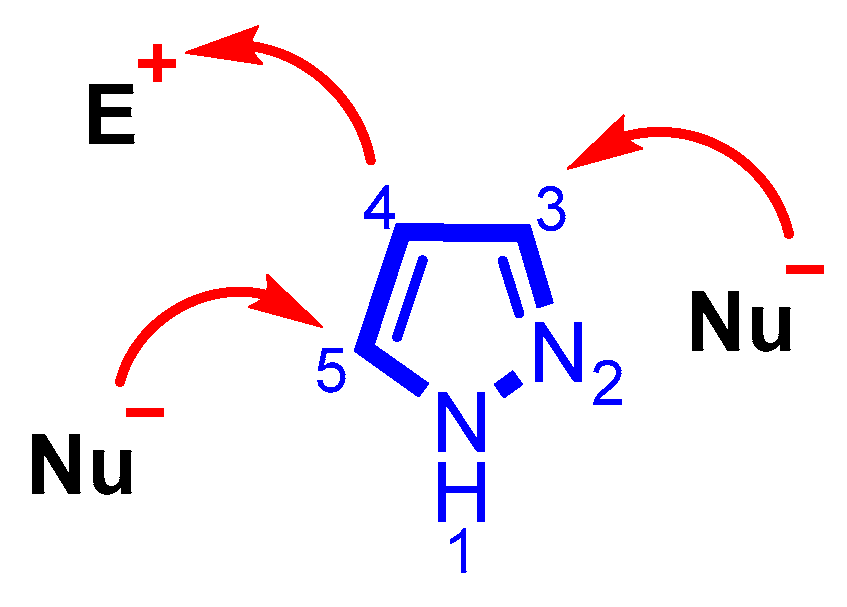

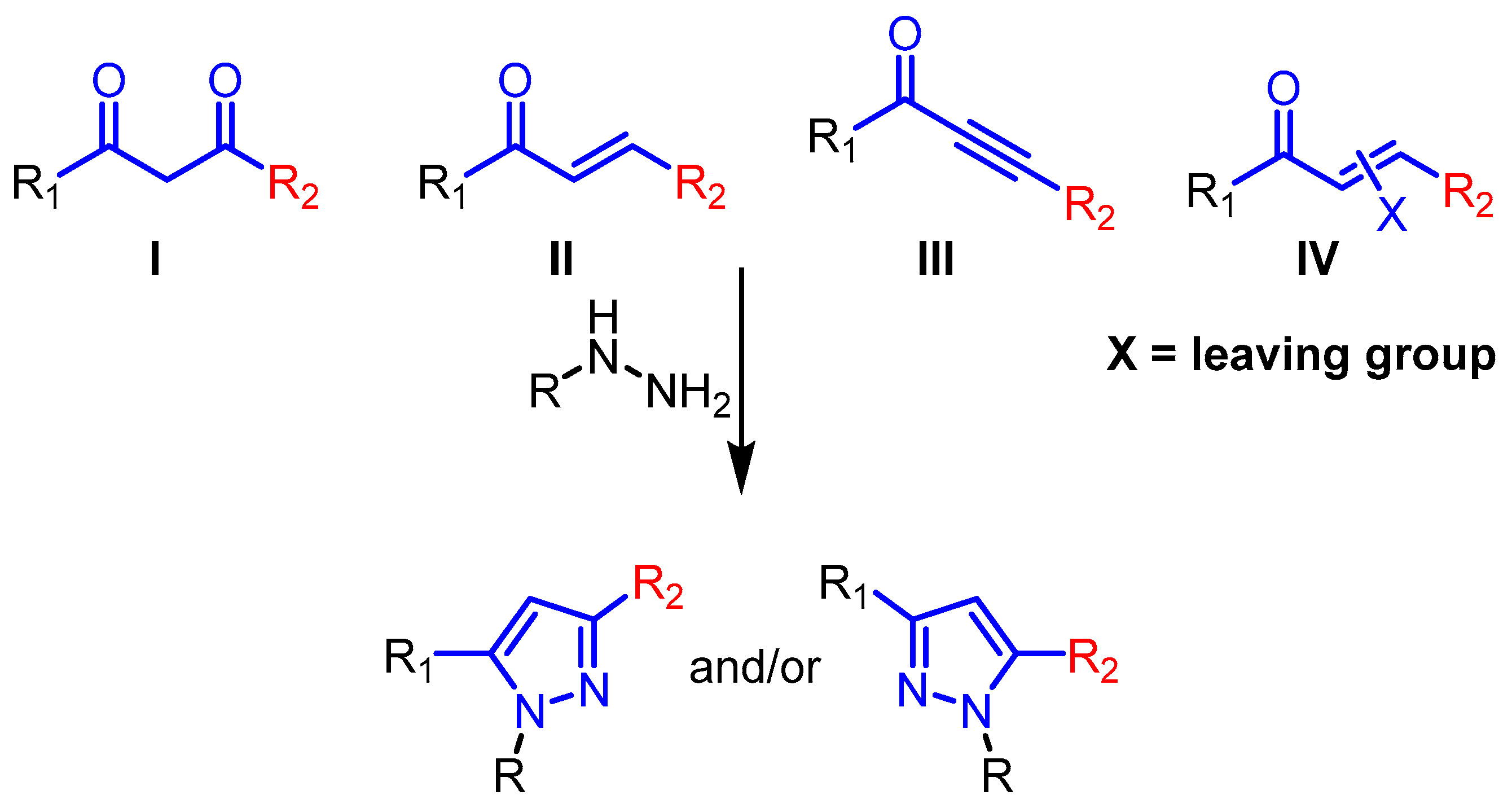



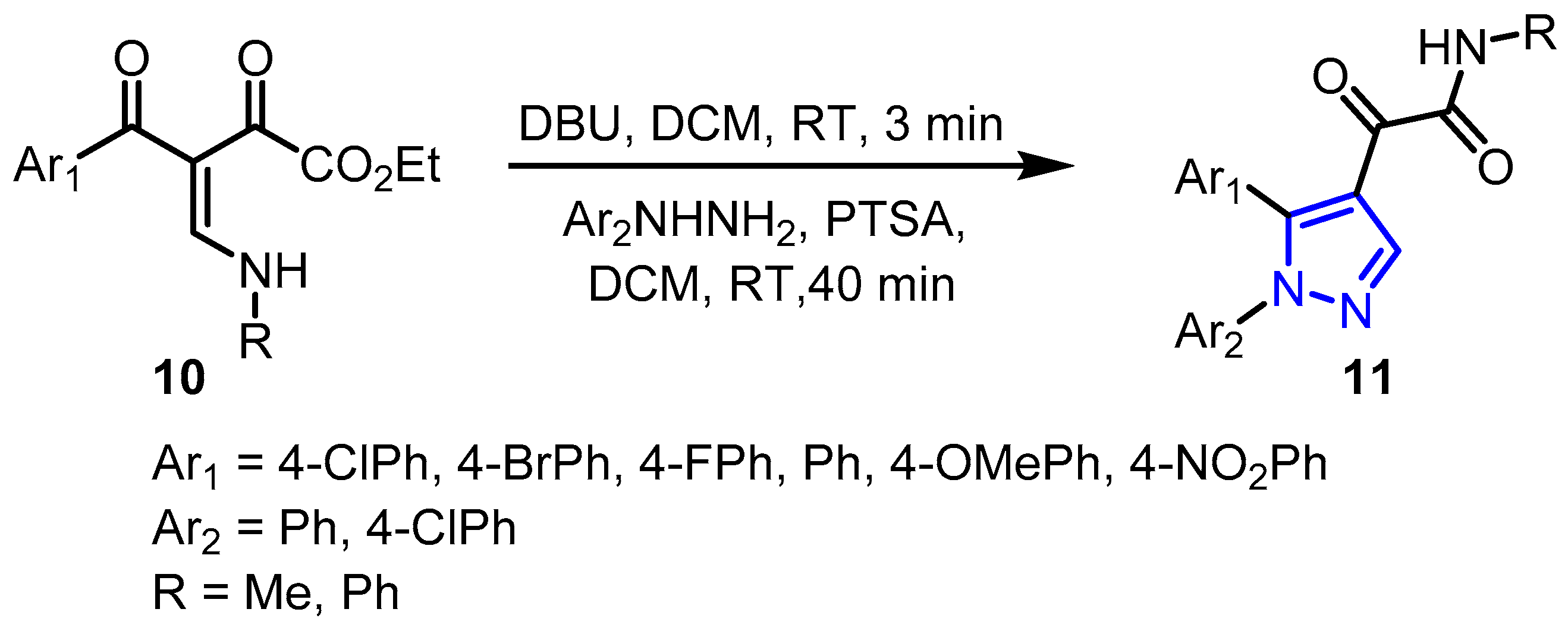


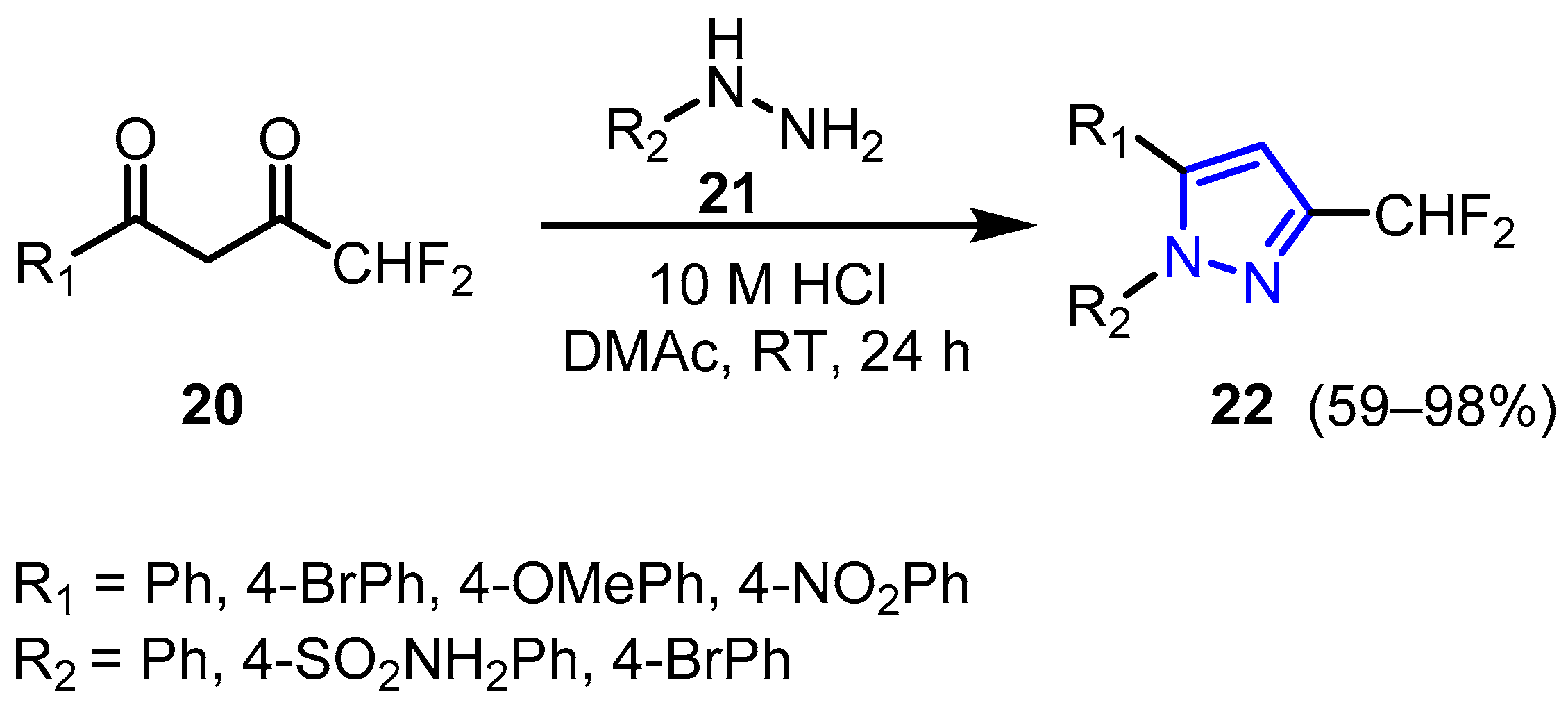
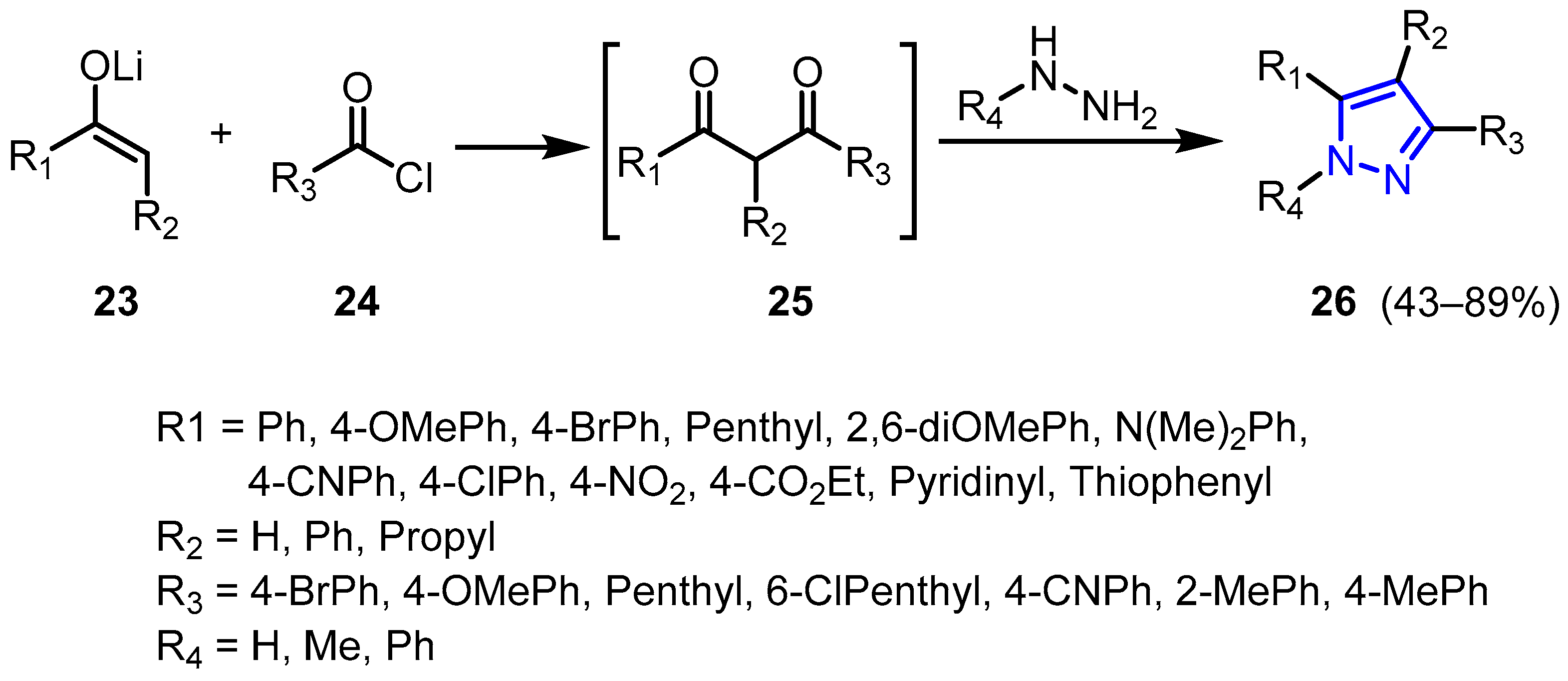
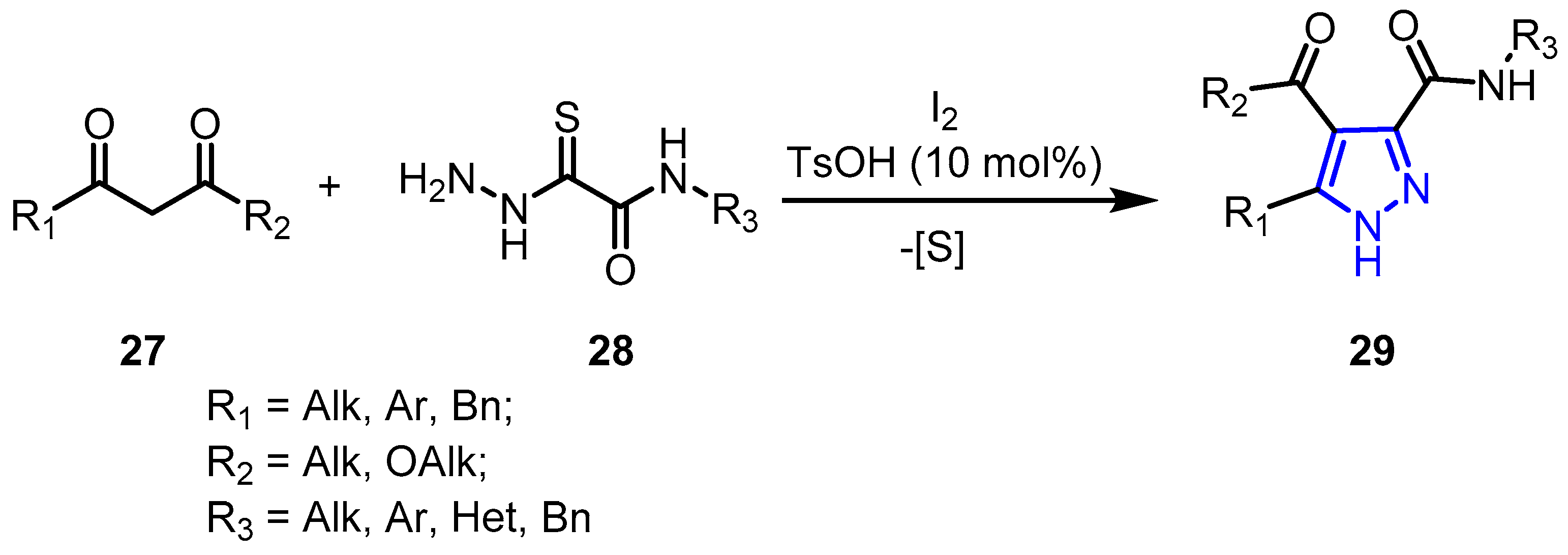
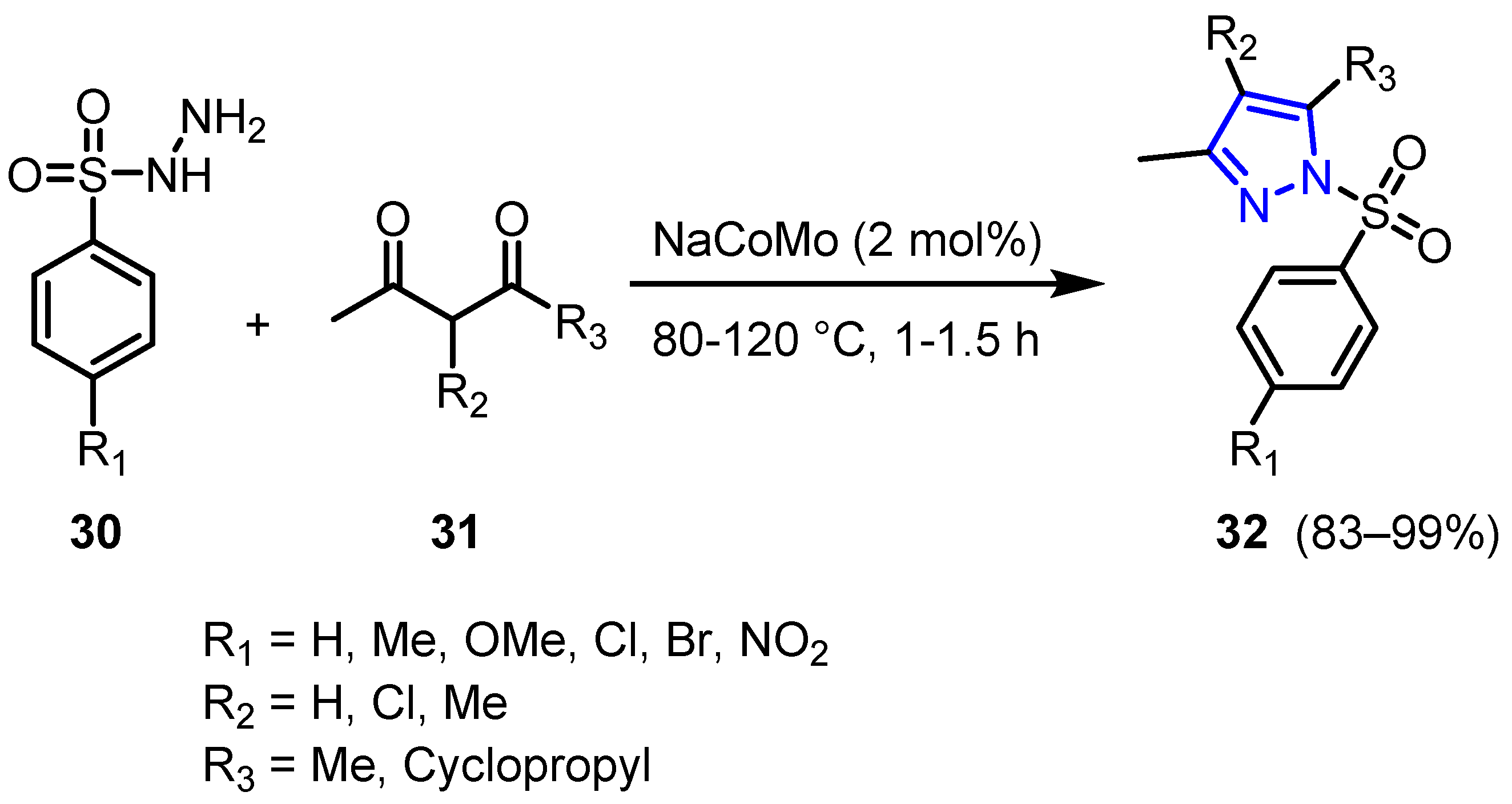

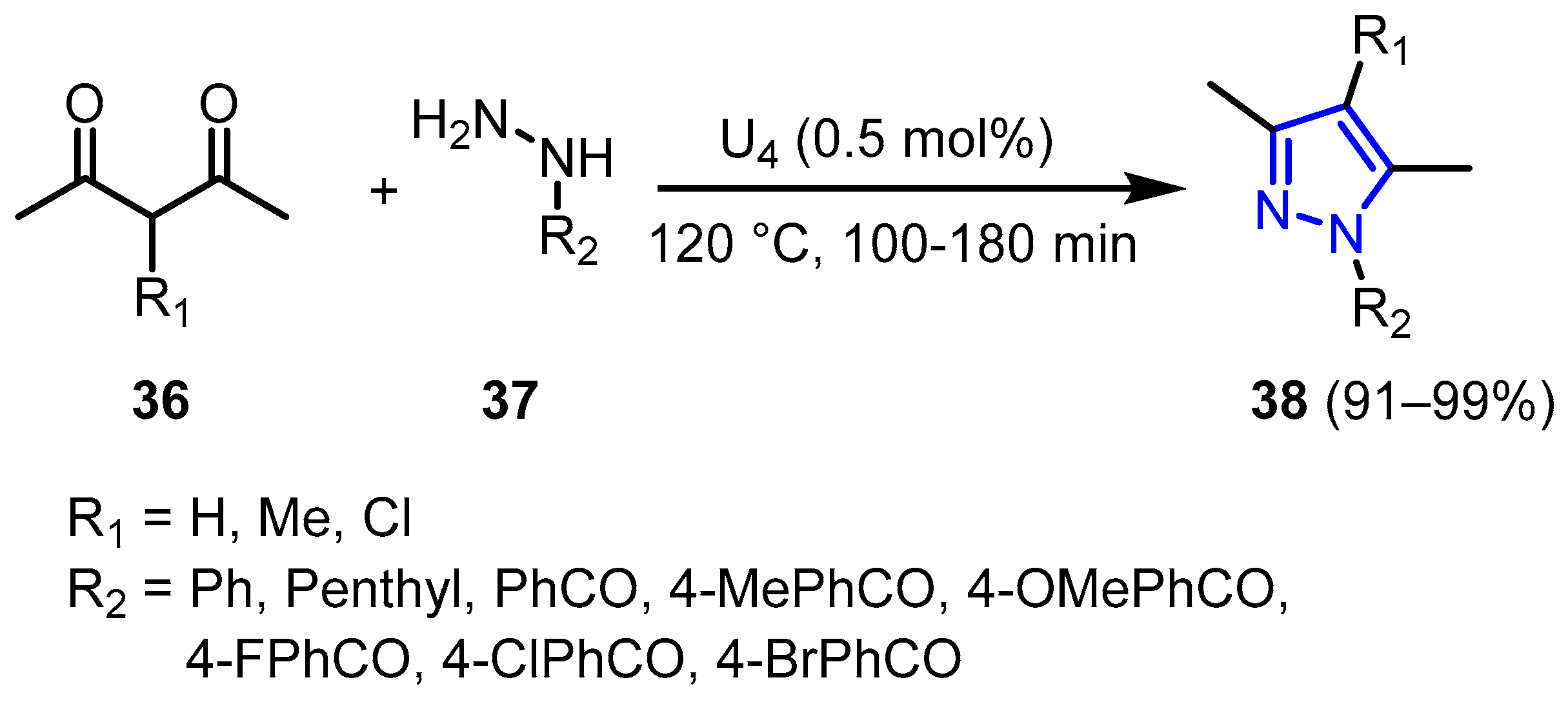
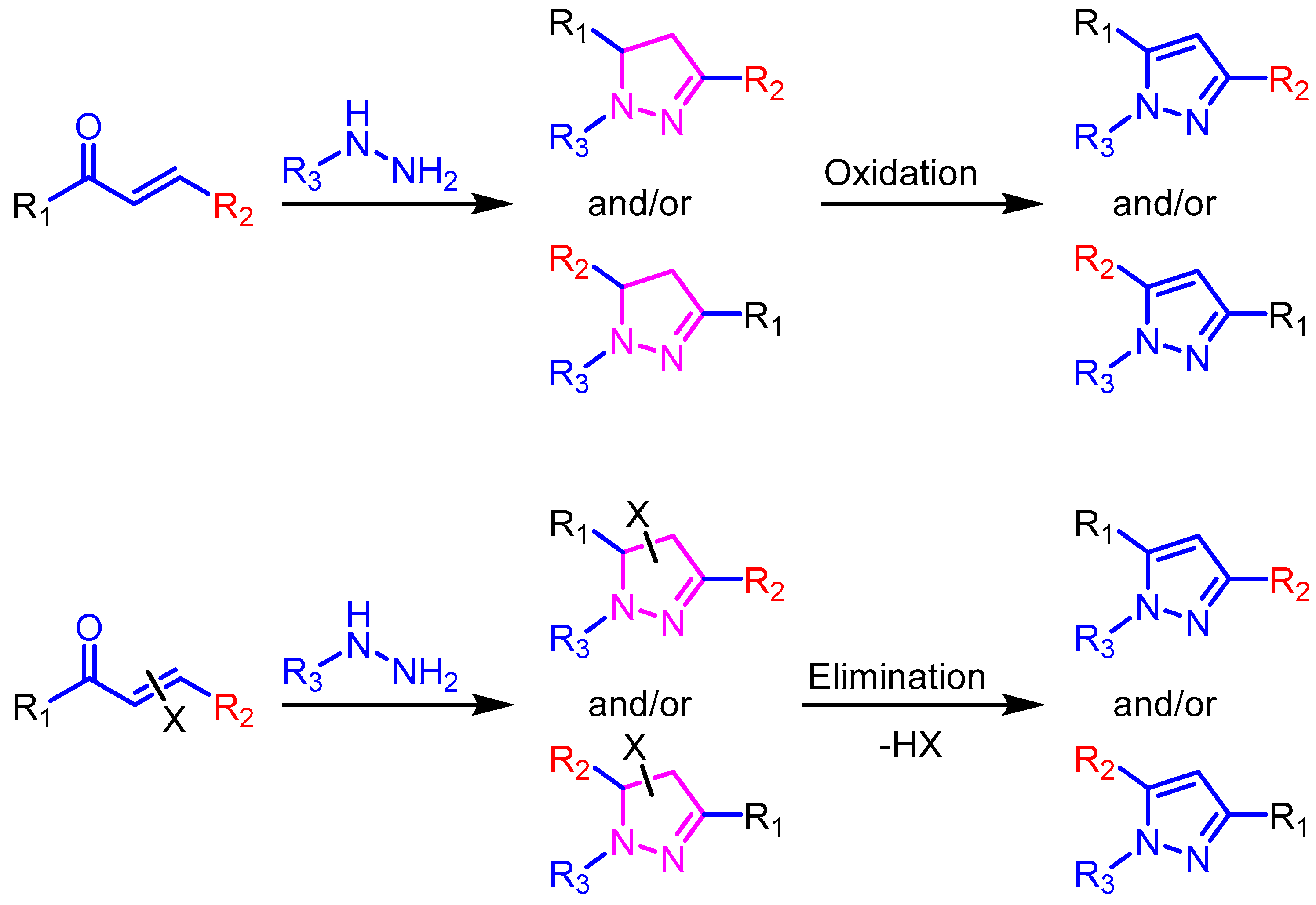
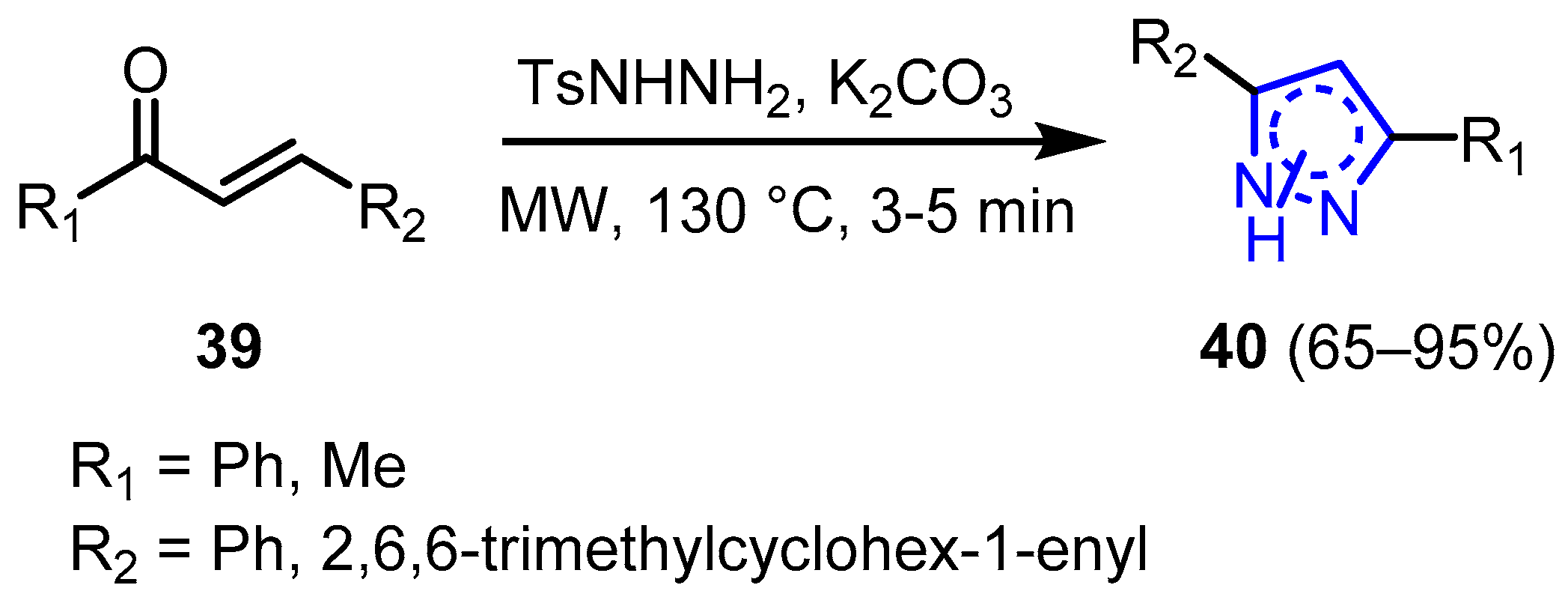




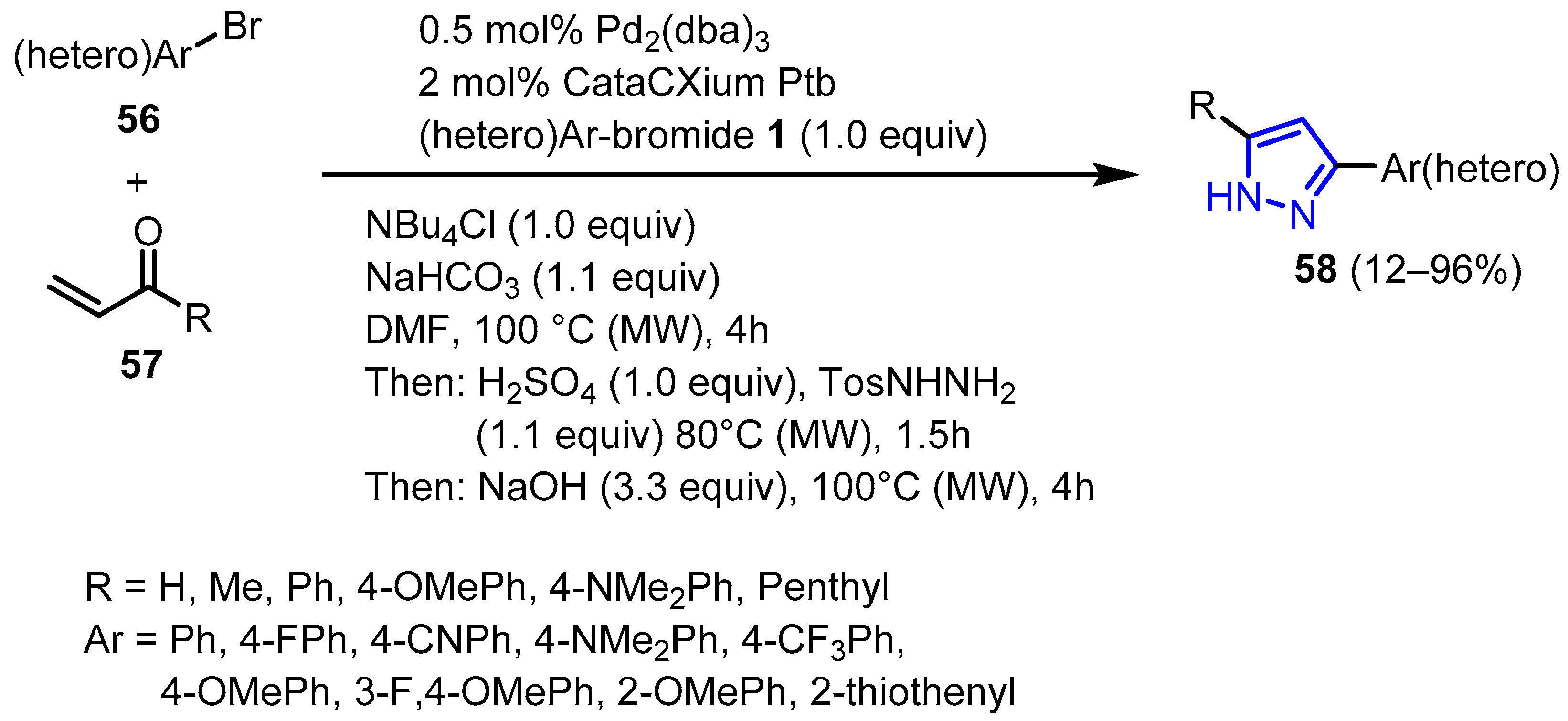








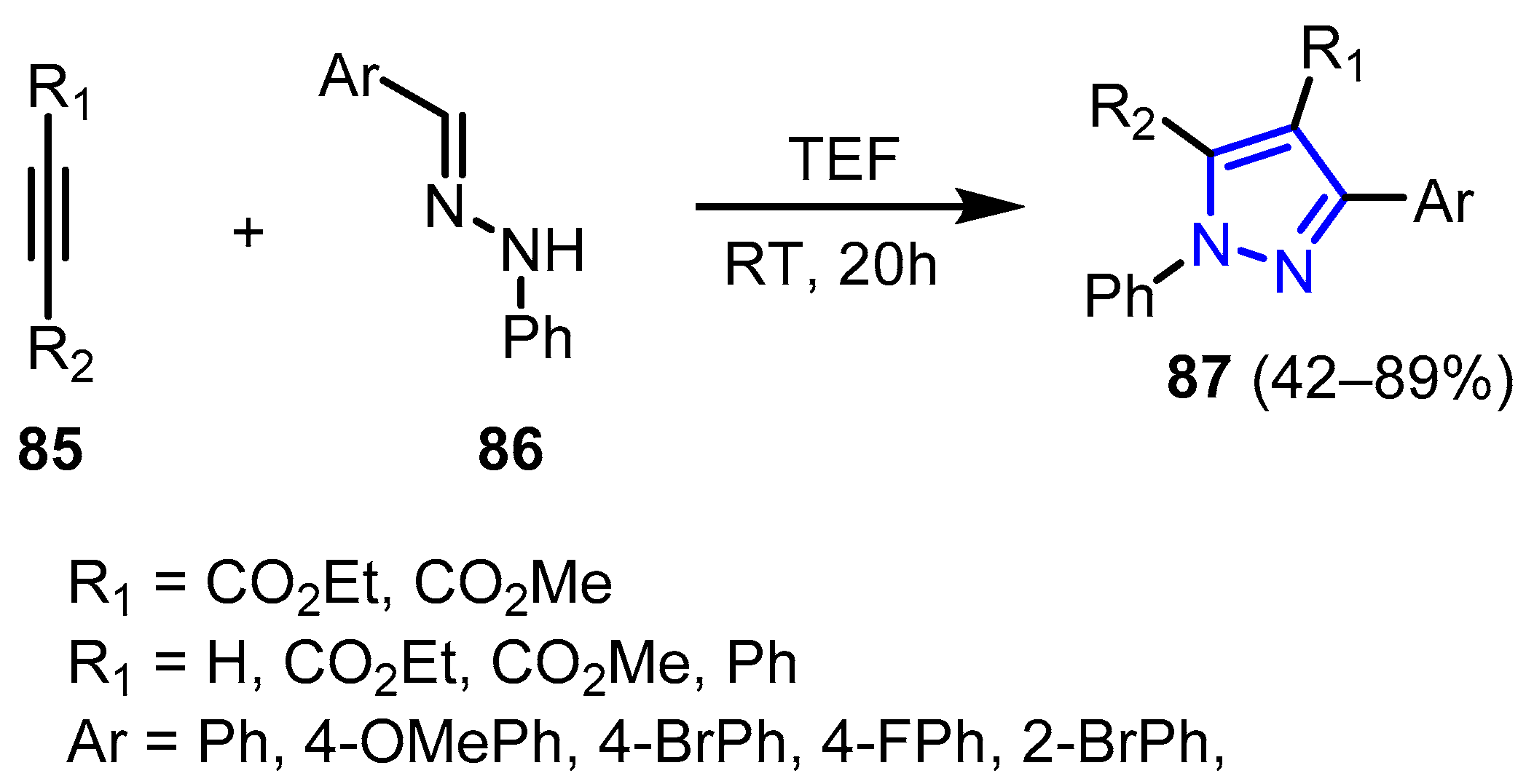
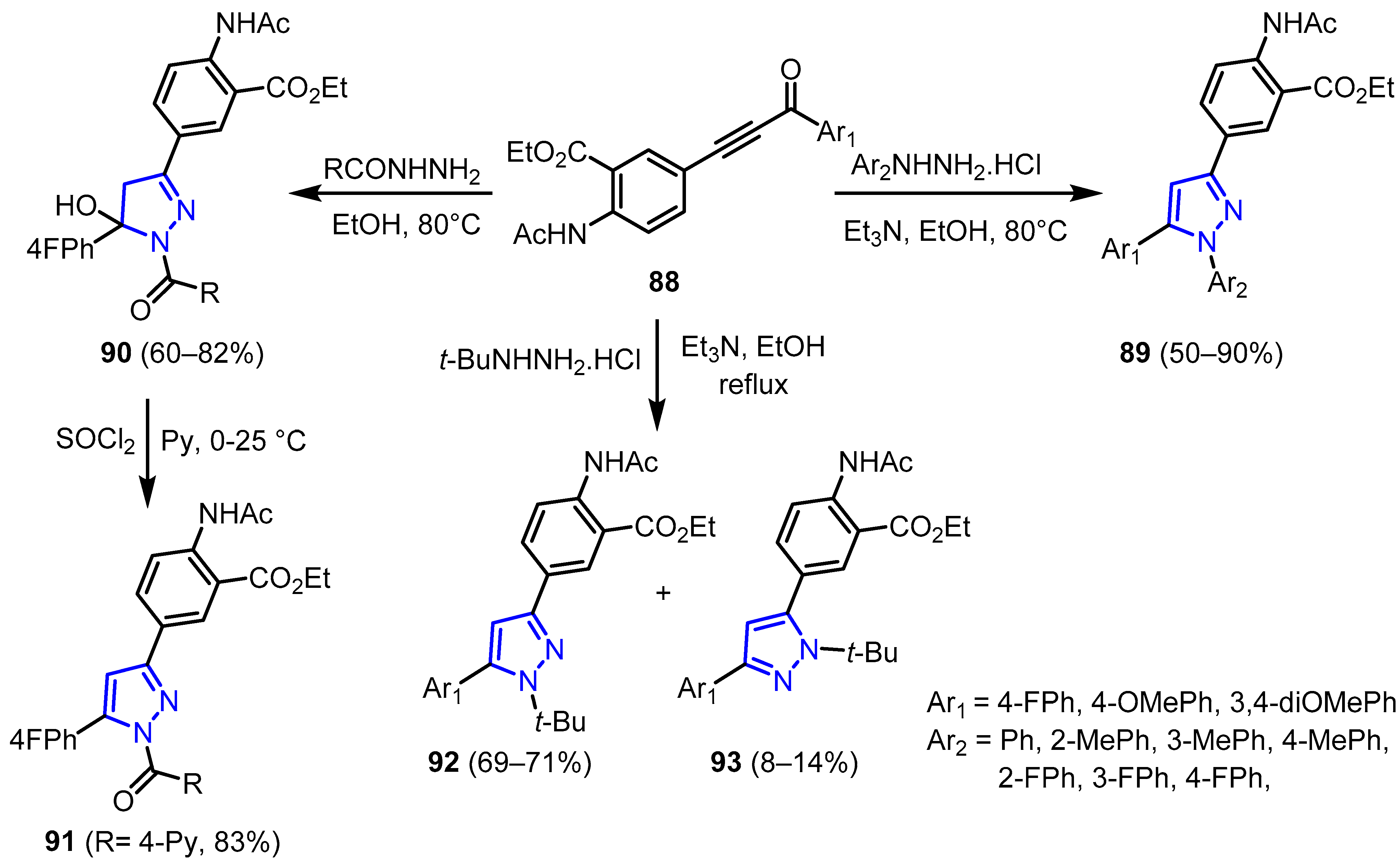
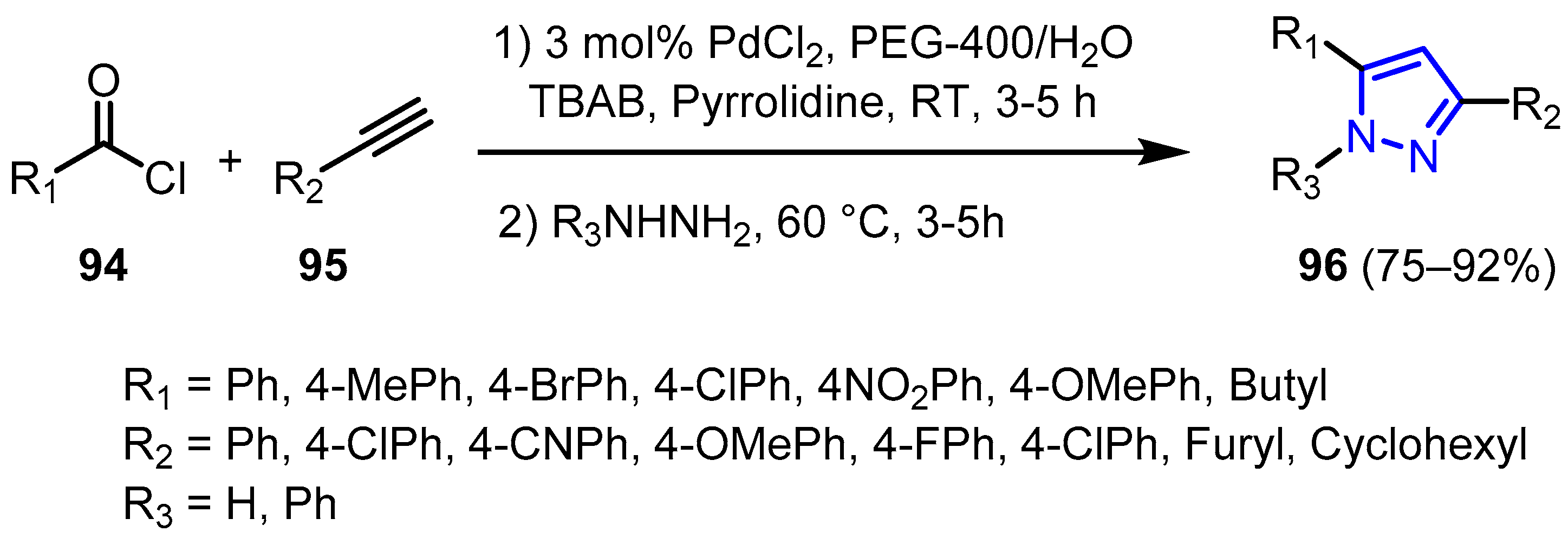
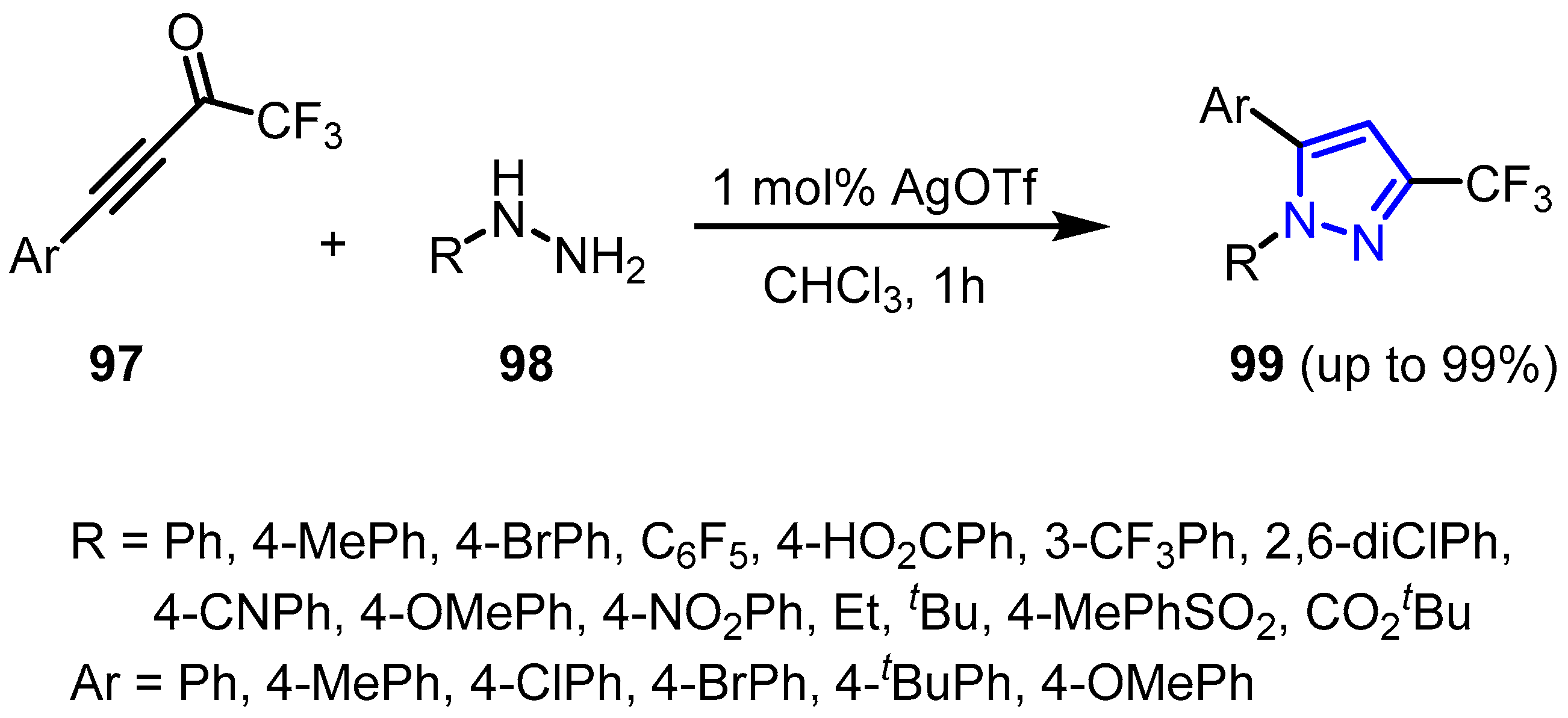
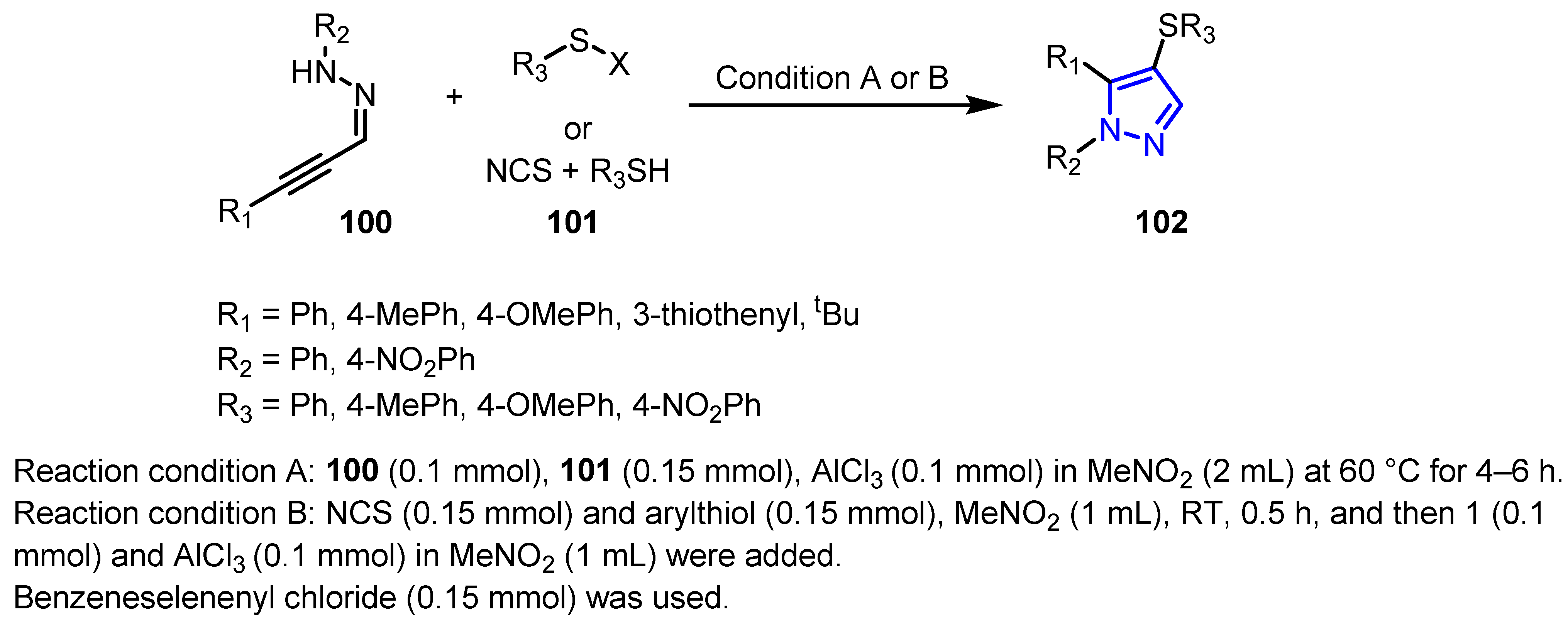
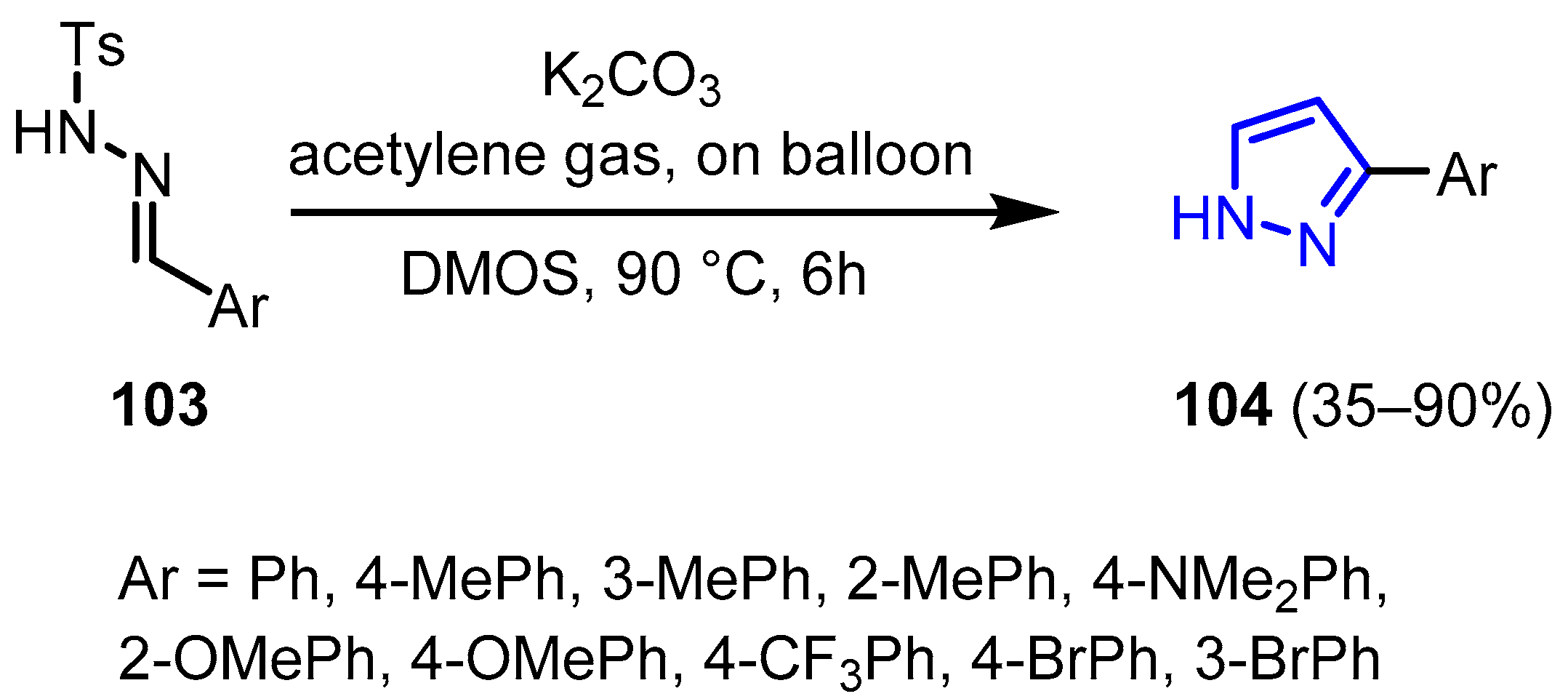
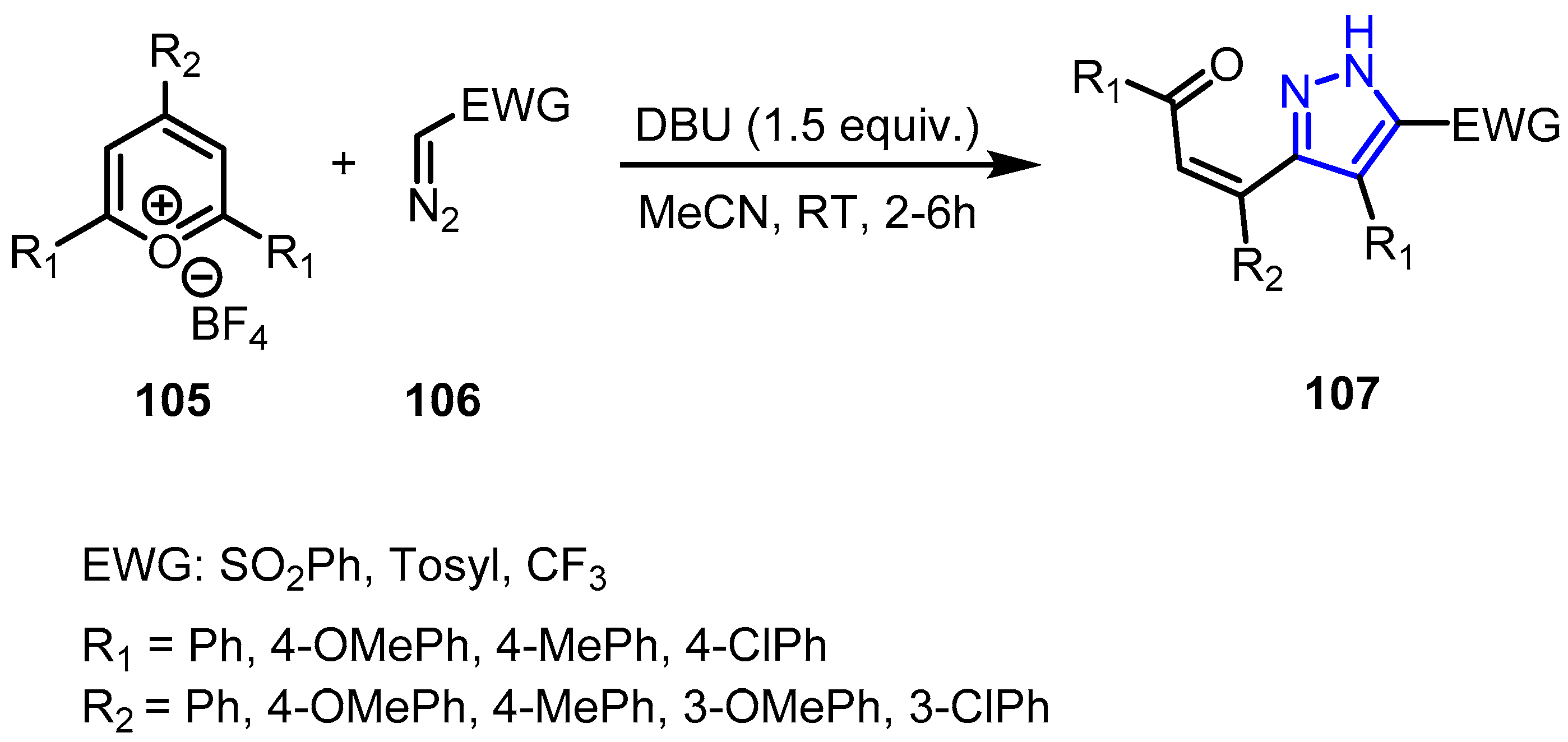
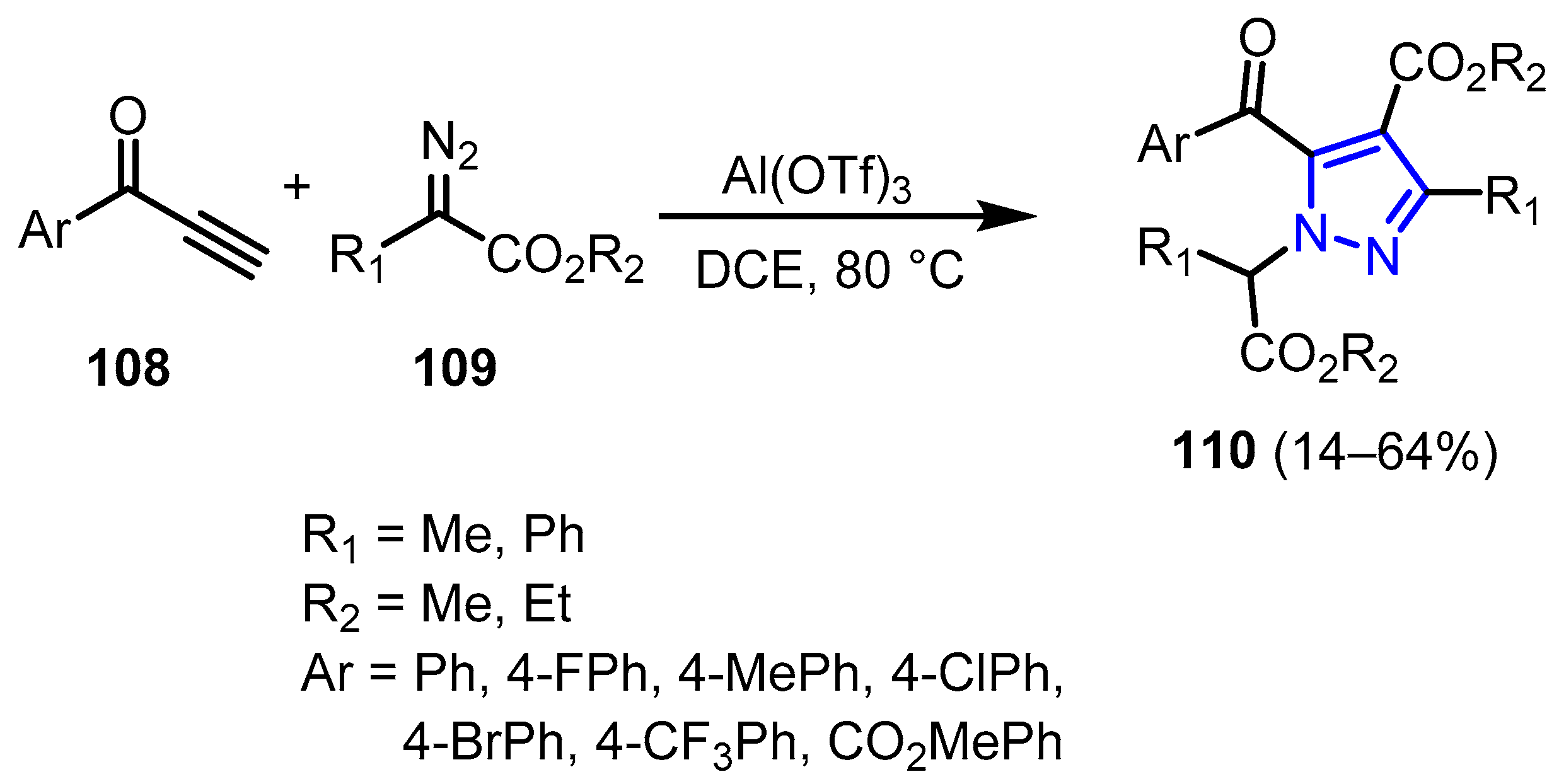

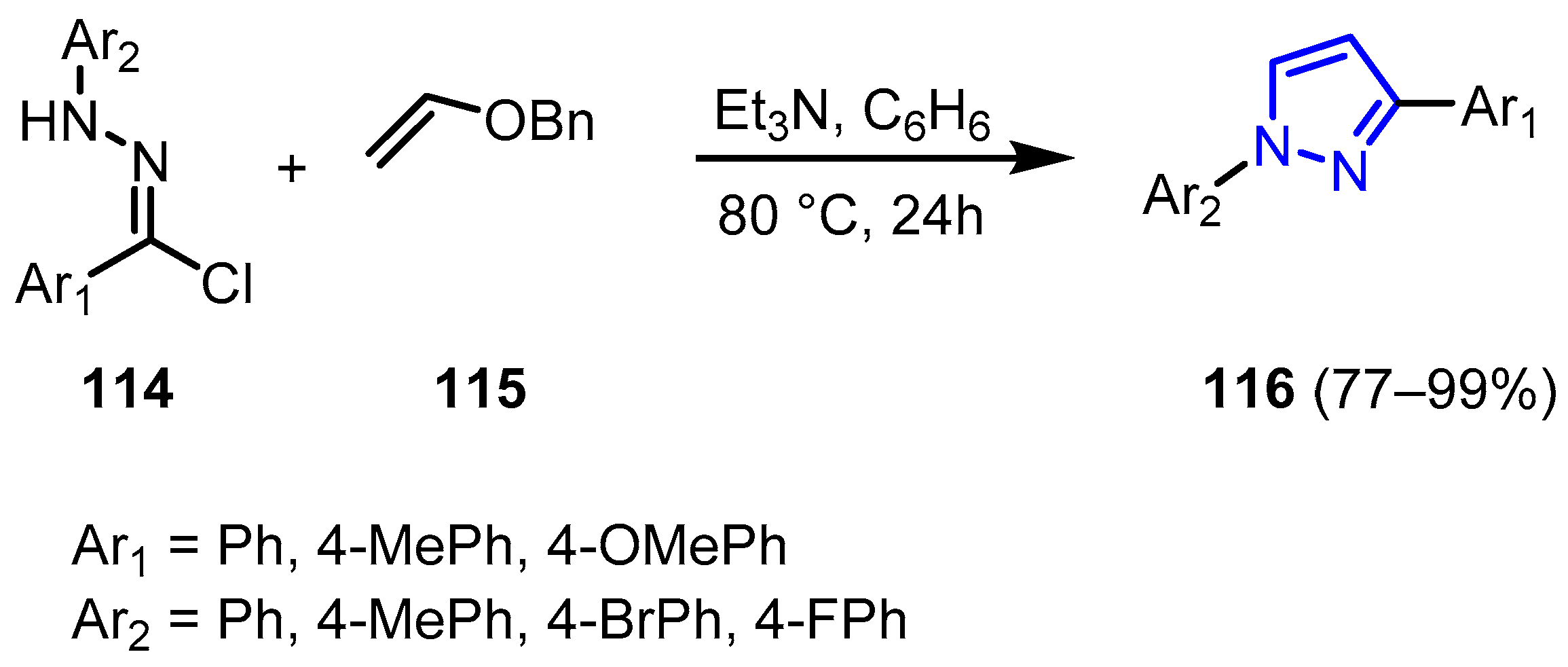
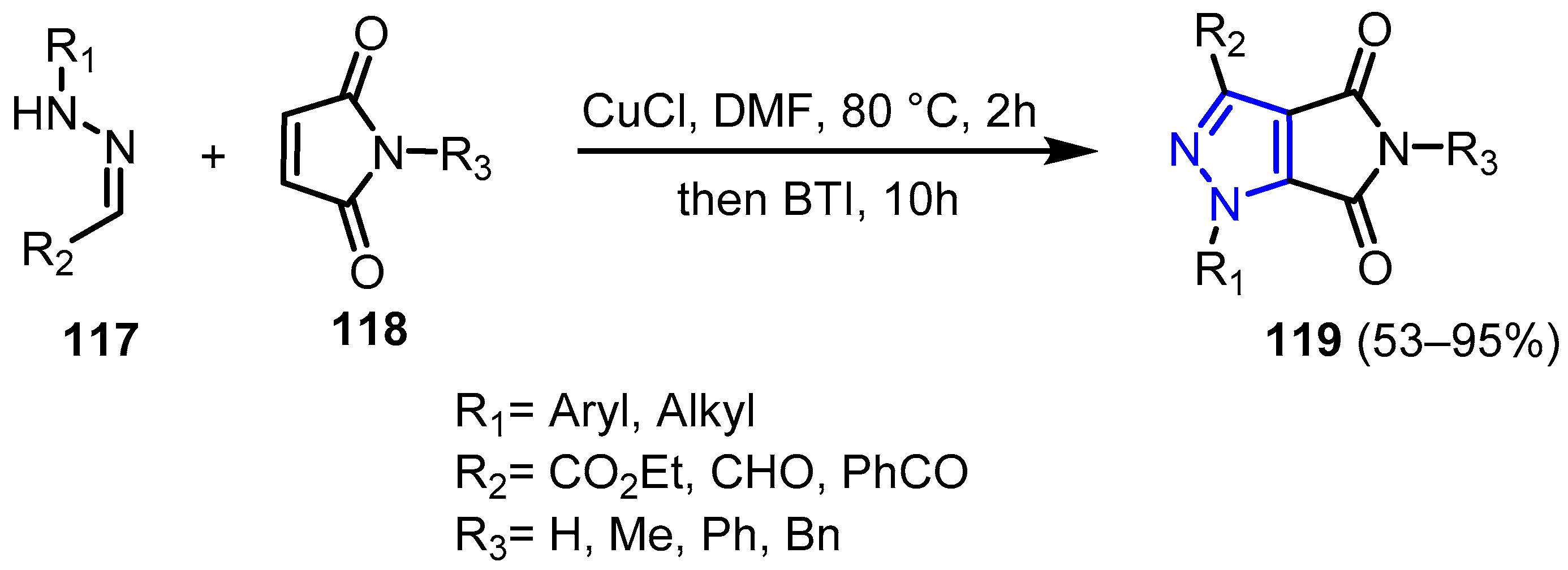
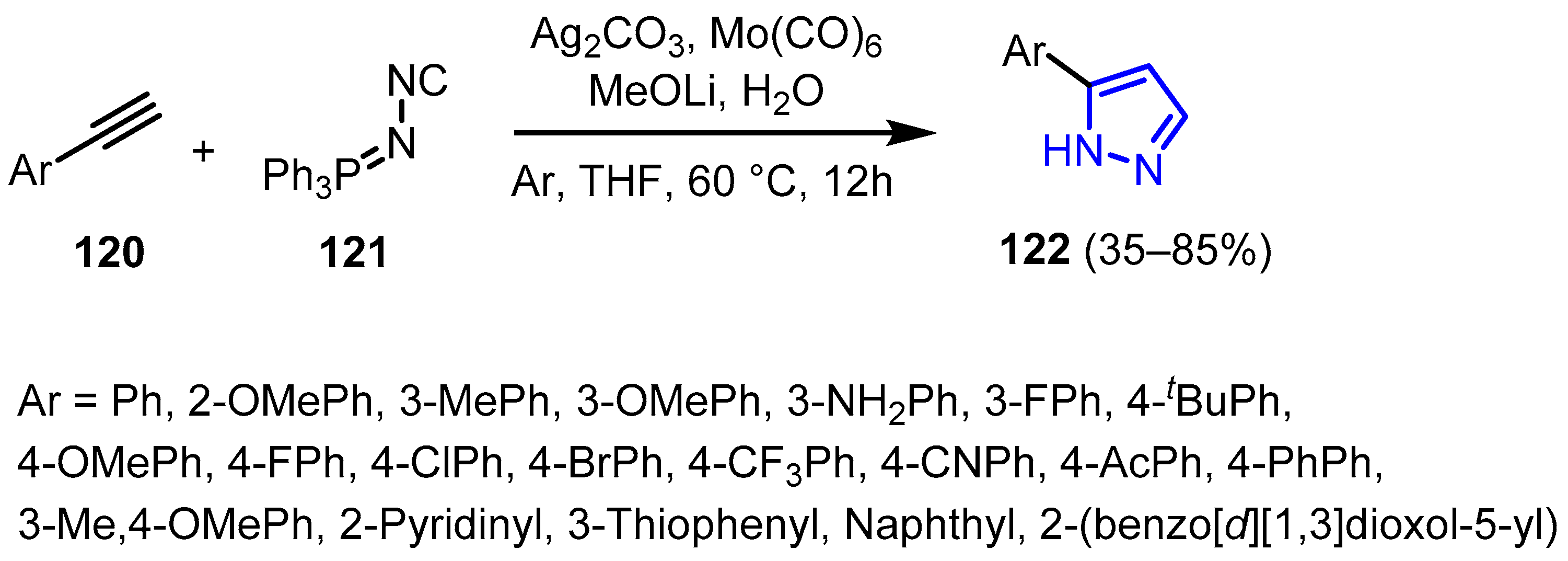
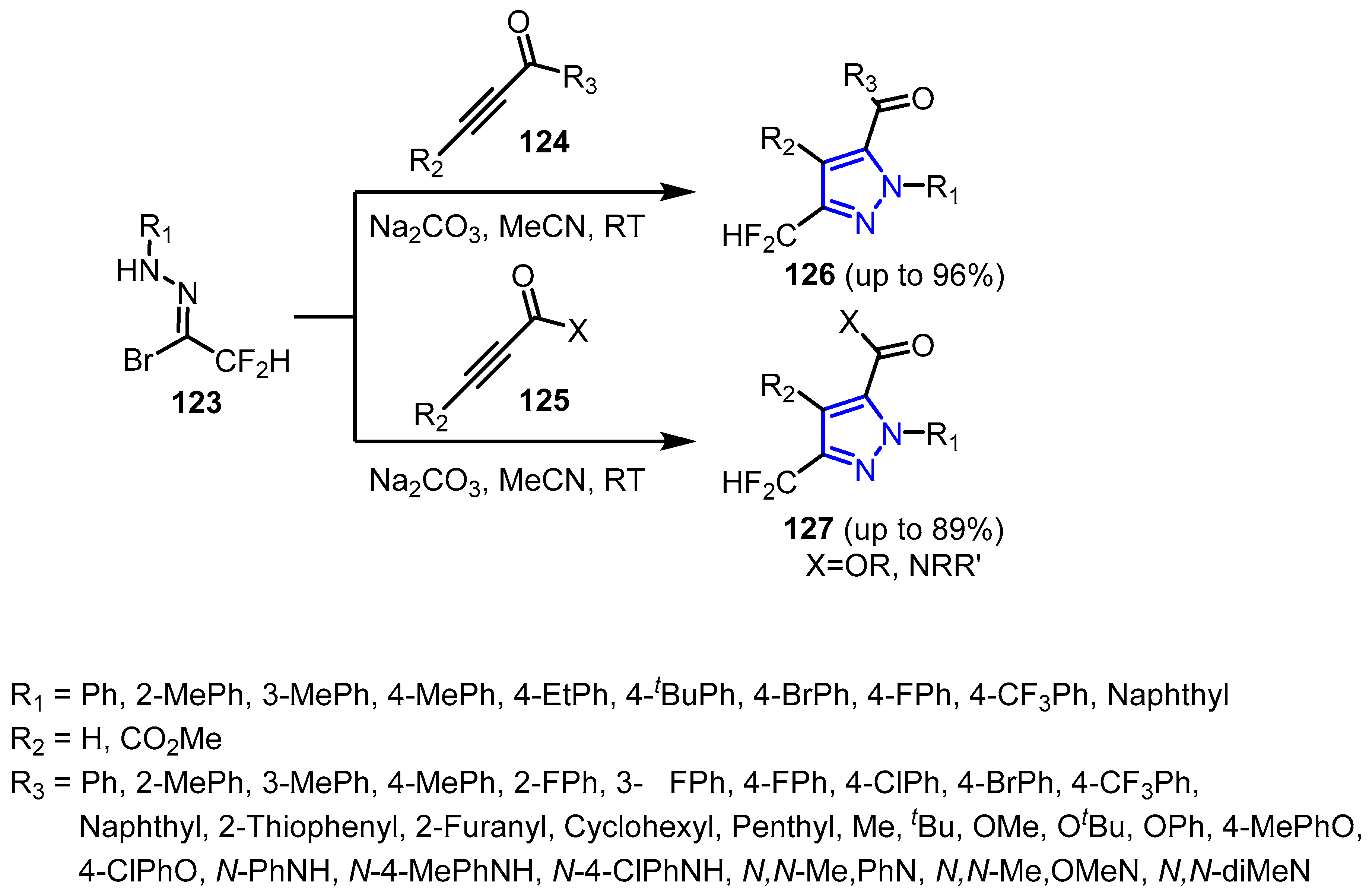
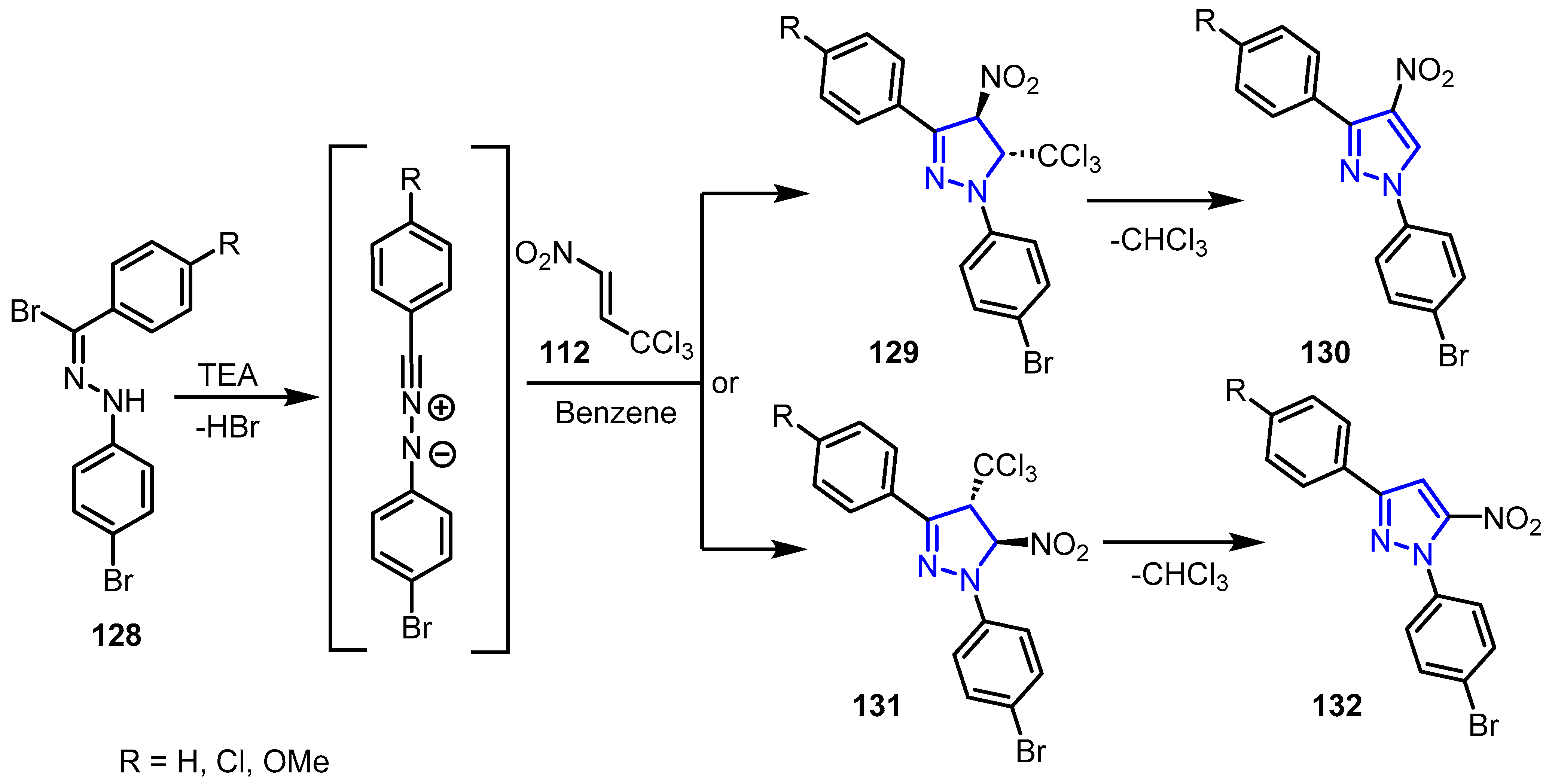
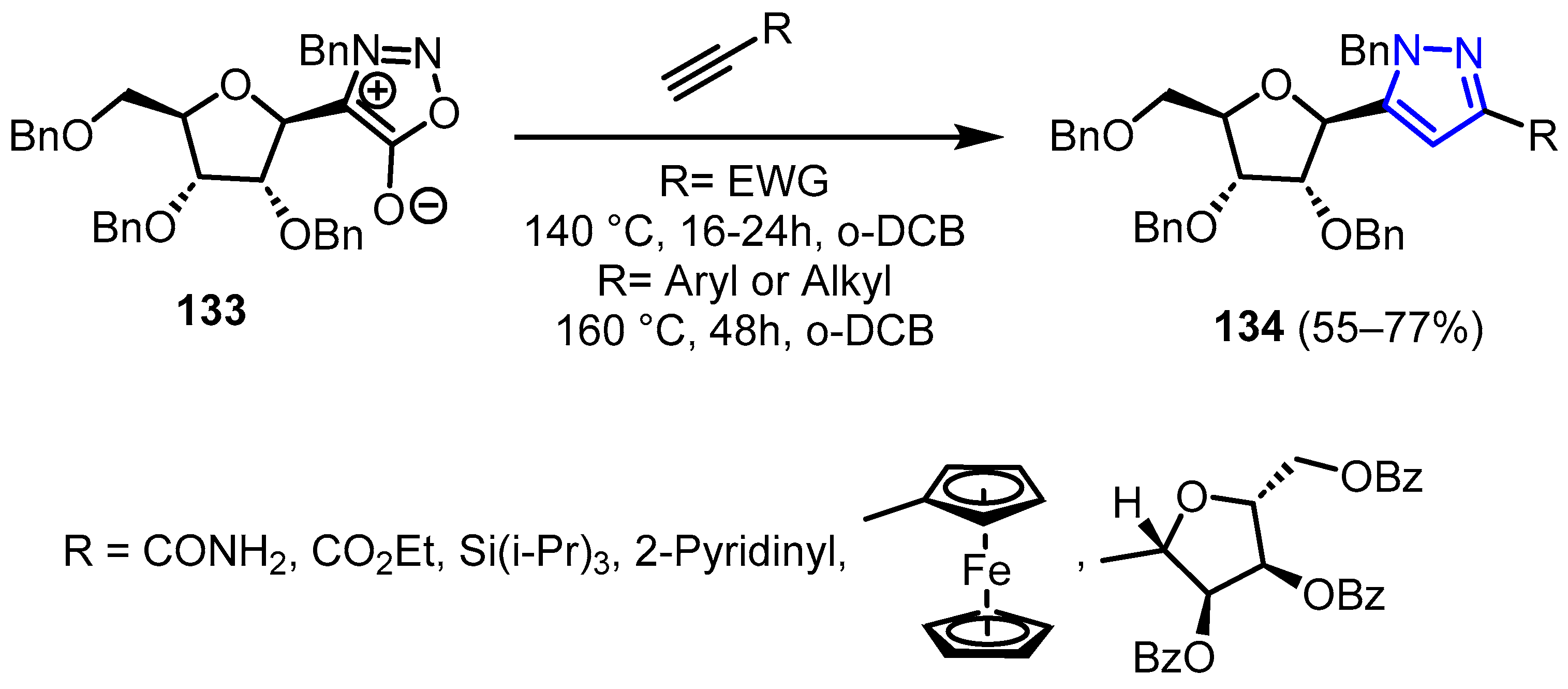
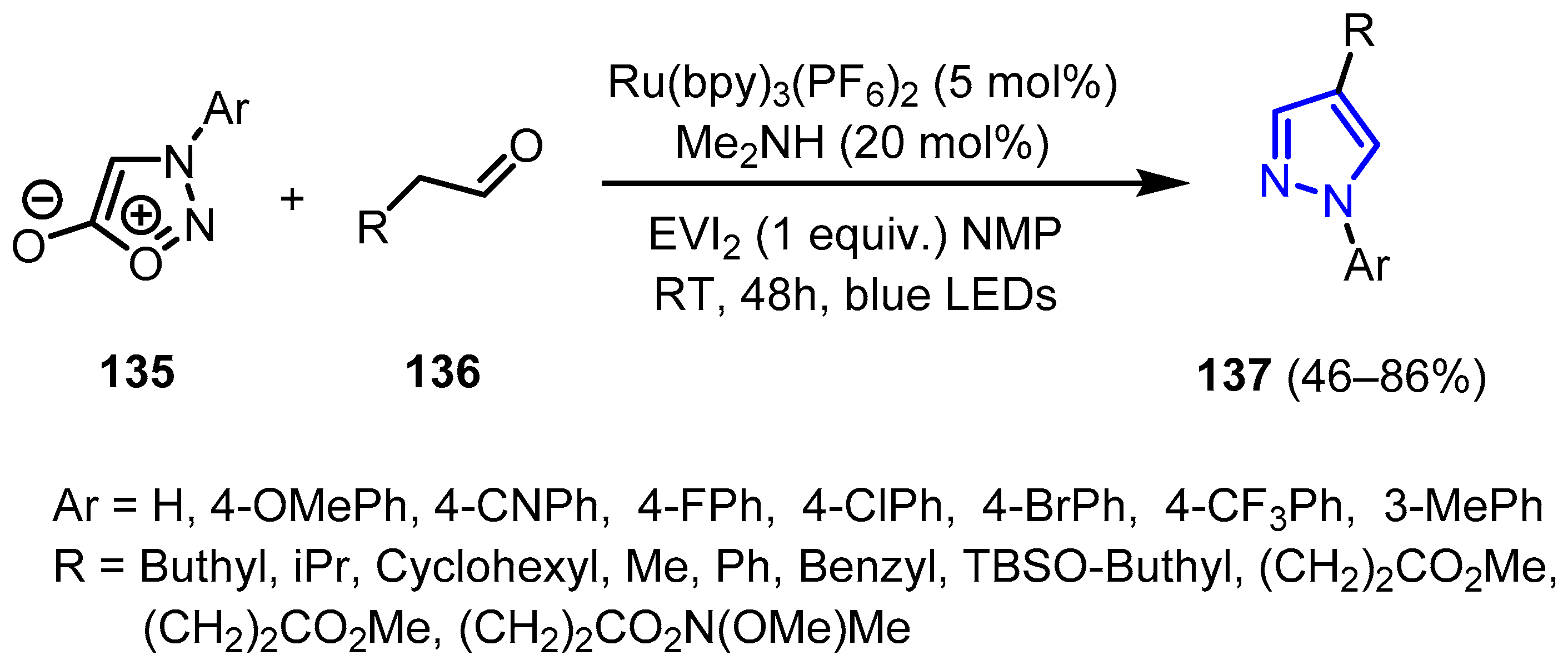

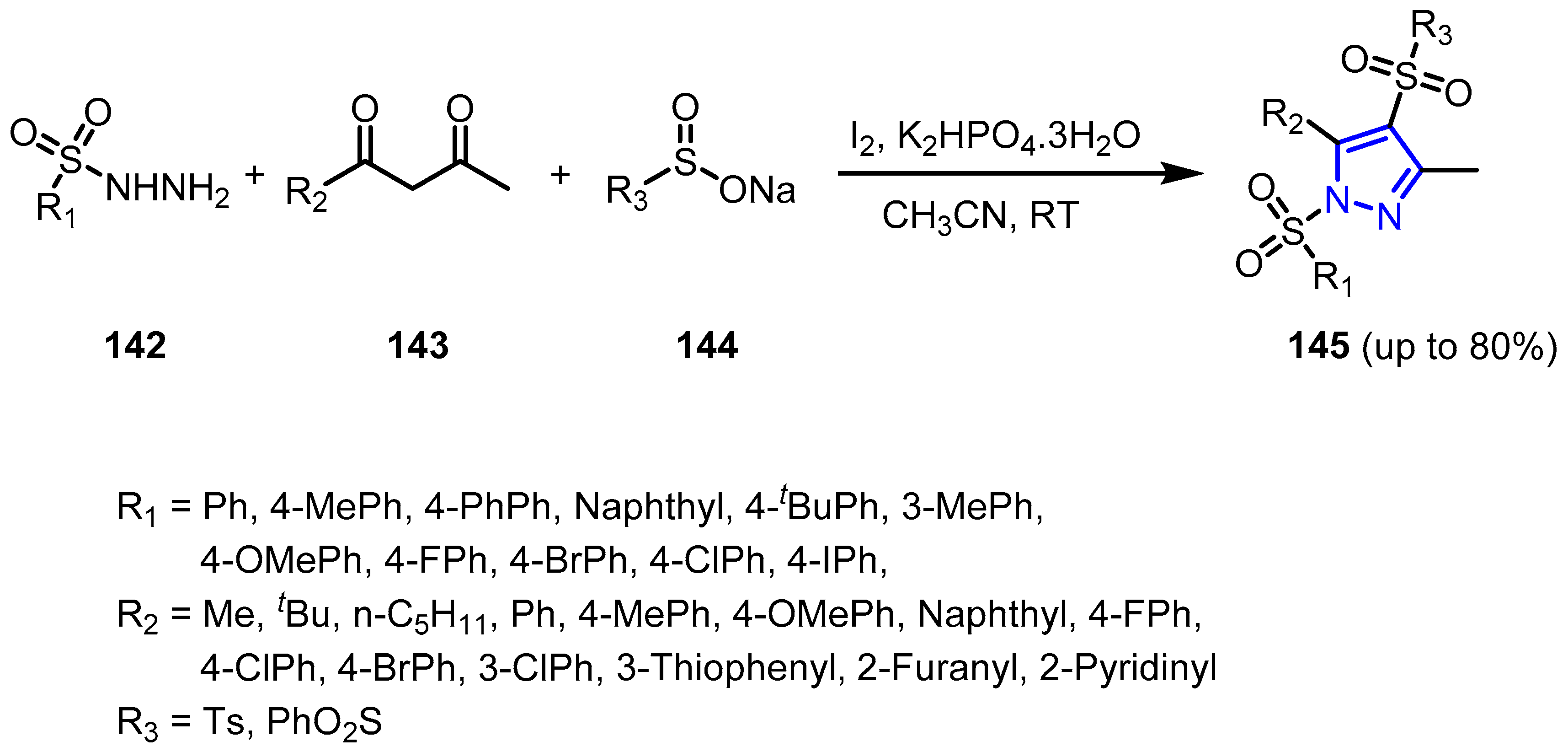
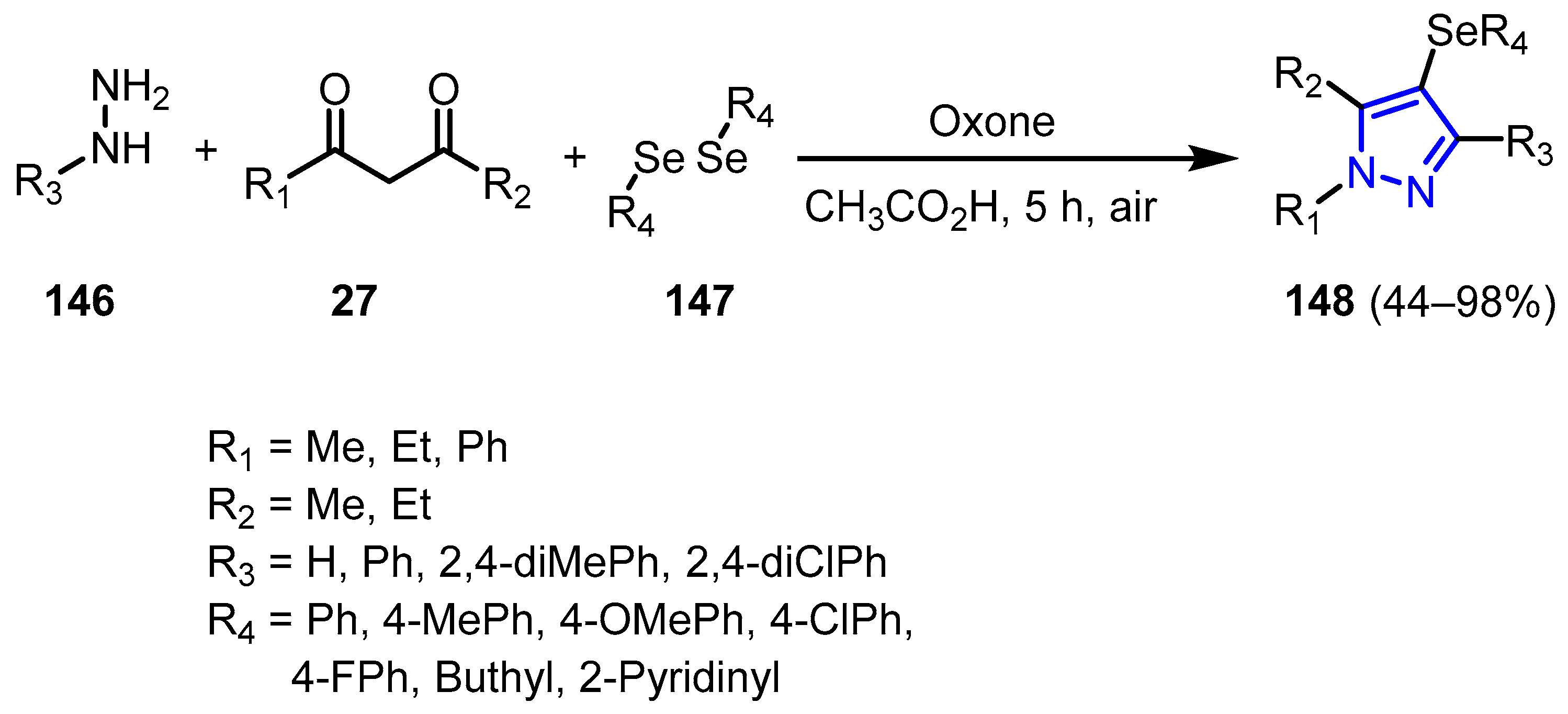
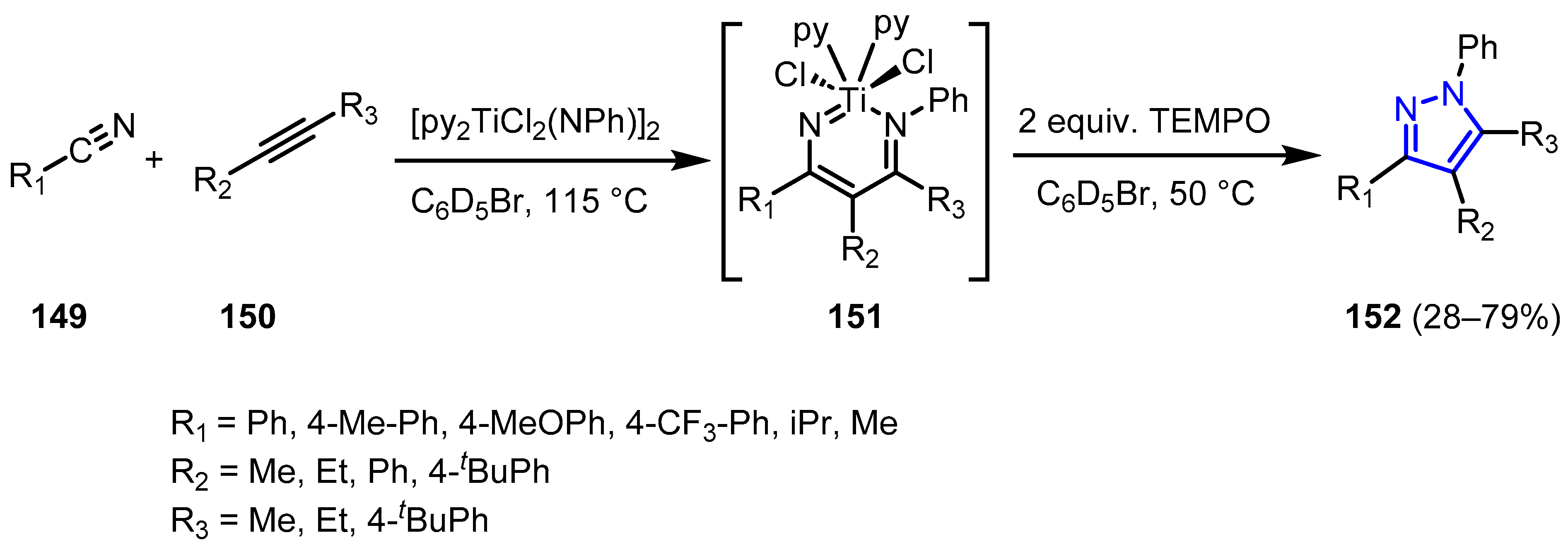
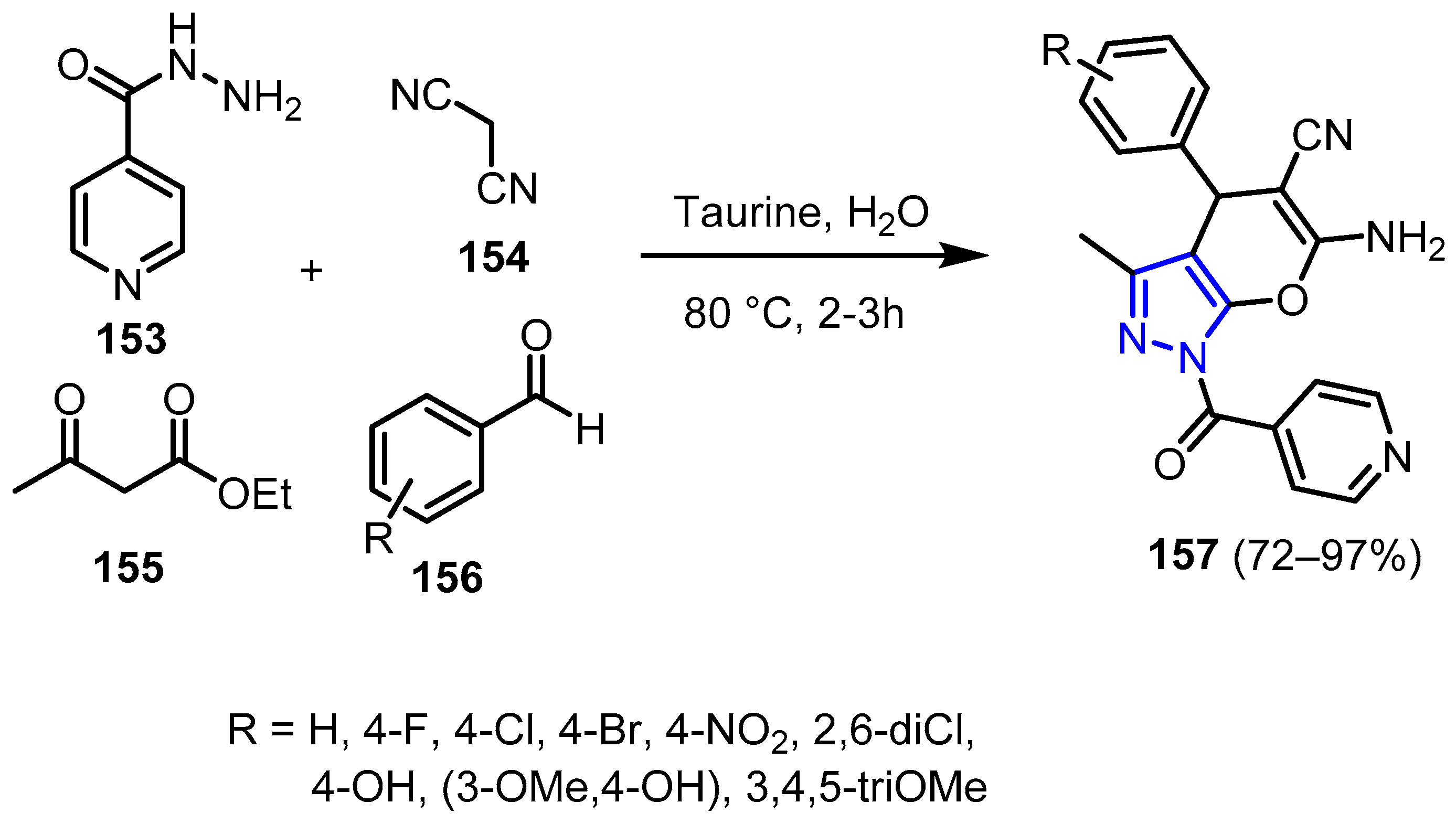
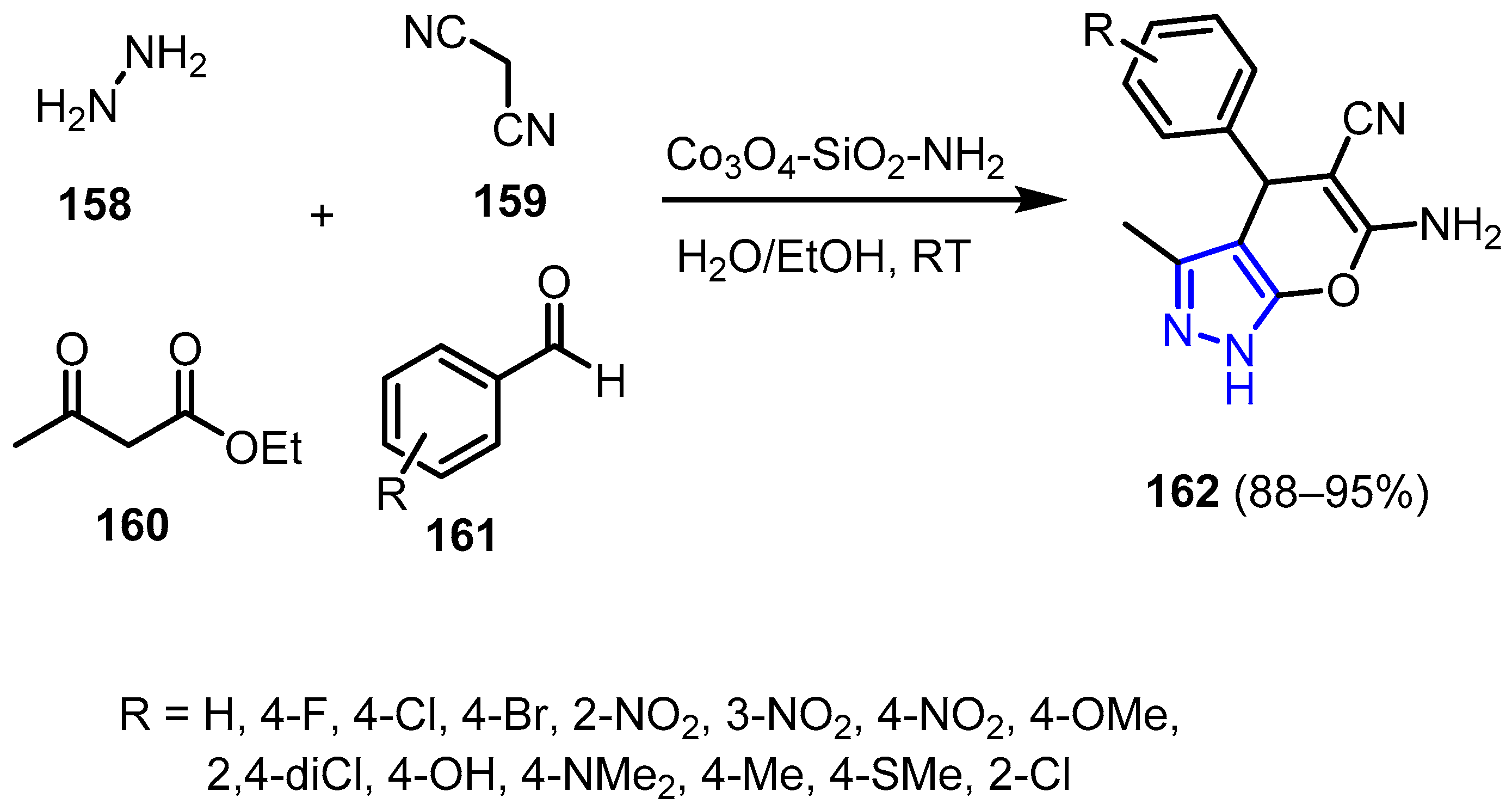
| R | R1 | Yield | R | R1 | Yield (%) |
|---|---|---|---|---|---|
| 2,4-diNO2 | H | 92 | 4-CN | H | 95 |
| H | H | 80 | H | Me | 90 |
| 4-Br | H | 90 | 4-Me | Me | 95 |
| H | Cl | 90 | 4-CN | Et | 85 |
| 4-Me | Cl | 95 | 4-NO2 | Me | 87 |
| 4-Br | Cl | 90 | H | Et | 92 |
| 4-NO2 | Cl | 90 | 4-Me | Et | 95 |
| 4-CF3 | Cl | 80 | 4-Br | Et | 80 |
| 4-CF3 | H | 70 | 4-Cl | H | 95 |
| 4-CN | Cl | 90 | 4-Cl | Cl | 90 |
Disclaimer/Publisher’s Note: The statements, opinions and data contained in all publications are solely those of the individual author(s) and contributor(s) and not of MDPI and/or the editor(s). MDPI and/or the editor(s) disclaim responsibility for any injury to people or property resulting from any ideas, methods, instructions or products referred to in the content. |
© 2023 by the authors. Licensee MDPI, Basel, Switzerland. This article is an open access article distributed under the terms and conditions of the Creative Commons Attribution (CC BY) license (https://creativecommons.org/licenses/by/4.0/).
Share and Cite
Ameziane El Hassani, I.; Rouzi, K.; Assila, H.; Karrouchi, K.; Ansar, M. Recent Advances in the Synthesis of Pyrazole Derivatives: A Review. Reactions 2023, 4, 478-504. https://doi.org/10.3390/reactions4030029
Ameziane El Hassani I, Rouzi K, Assila H, Karrouchi K, Ansar M. Recent Advances in the Synthesis of Pyrazole Derivatives: A Review. Reactions. 2023; 4(3):478-504. https://doi.org/10.3390/reactions4030029
Chicago/Turabian StyleAmeziane El Hassani, Issam, Khouloud Rouzi, Hamza Assila, Khalid Karrouchi, and M’hammed Ansar. 2023. "Recent Advances in the Synthesis of Pyrazole Derivatives: A Review" Reactions 4, no. 3: 478-504. https://doi.org/10.3390/reactions4030029
APA StyleAmeziane El Hassani, I., Rouzi, K., Assila, H., Karrouchi, K., & Ansar, M. (2023). Recent Advances in the Synthesis of Pyrazole Derivatives: A Review. Reactions, 4(3), 478-504. https://doi.org/10.3390/reactions4030029






